How to become a better marketer
Table of Contents
Introduction
Every self-proclaimed expert tells you to have good landing pages, an irresistible offer, send out emails, and so much else.
Just Google “How to grow a business” and you’ll find a zillion things you must do: Blogging, Facebook PPC, Lead Generation, Newsletter, get featured on Entrepreneur Magazine, build your Funnel, Copywriting, Affiliate – yeah, for sure. As if you had so much time to do all this stuff.
It only leaves you in a, what I call, tactical maneuver hell.
You don’t have the time and you shouldn’t do all of it.
Why?
Money loves speed, there isn’t time to do it all. You have to find out what tactic earns you the most money and which are costing you money.
There is something that I call the Marketing Intersection and it helps you to understand how marketing is meant to be done.
Truth is, there is too much information out there.
So, I’ll keep it simple and short. The Marketing Intersection will
- lift the curtains behind marketing,
- show you the missing link behind successful advertising,
- how to put every piece in the correct place and
- where you should invest your money and more importantly
- where you should divert your attention to (time aspect)
The principles are based on mathematics and human nature.
No fancy words to redescribe something that everyone knows.
Because this is what most gurus do. They come up with acronyms for things that have been known in the marketing world for decades just to sell it as secret sauce to get more leads, have better advertising response whatsoever.
Will this work for my business?
Jop. Sure, every business is different, different challenges, different goals, different legal issues and dozens of other obstacles.
You will see the concept here. It’ll help you to understand how each piece of the puzzle works together – and this is my sole goal here. You will need some hours of planning, implementing and testing, jop. But that’s it. (Haha, sounds easy)
But before it can work for you, you need to understand three fundamental truths.
Fact #1: People want what they want and
not what you want them to want
Most business owners try to sell their product to people who don’t want this particular kind of product. And its madness. It doesn’t matter how good your advertising is, it will inevitably fail. So, tell me what does your ideal customer really want?
What experience does he crave? What problem will he solve with your product? If you speculate here, then everything you do with your marketing will fail.
I’ll be blunt with you. Just because you have a better product will not lead to many customers. The idea of inventing a better mouse trap and hundreds of people will fall with the door in your house will lead to entrepreneurial failure. Without a single doubt.
No matter how valuable you believe your product is, is it really what your customers want? Will it help them to solve the problem they deeply care about? If not, you should go back to the drawing board and redefine your product before you can start thinking about any marketing strategy.
Fact #2: Value is in the eye of the money holder
You think your product is the best? But what about your customers? Do they think the same? Or did they classify your product as a mere commodity?
How many times did you play with the thought of lowering your prices to get more customers and then after you achieve this, increasing them again? Do it and people will always expect low prices.
Not to mention that low prices are not a good strategy to grow any business. Don’t play the game of who can go lower. Because there will always be someone who will cut prices.
If you want to attract customers that buy over and over, stay loyal to your brand you need to accept the fact that value is in the eye of the money holder. And if you try to change the perception of your prospects, you’ll fail.
When we talk about the buyer journeys soon, you’ll find out why this happens and what you can do to avoid it.
Fact #3: Relevance
You need to be relevant. And by that, I mean you need to tell your customers what they want to hear. Have you ever heard about objections like “I don’t need that right now”, “Not now, I’ll have to talk with someone about it” etc.?
It is because you haven’t been relevant. Let’s assume someone suffers from acne. These people no longer want to go out with their friends, they hate the idea of having their picture taken and just want to hide.
Telling this person, he has a problem is ridiculous. He knows it. He wants to have it gone. He wants to live his life again. Shoving him an ad in his face and dramatizing about how bad it is, is counterproductive.
However, if you show them a solution that speaks directly to their desires, you’ll get their attention. Instead of saying, “Acne is terrible! You need this product!” which they already know, you should focus on the outcome they crave.
For example, say something like:
“Imagine waking up with clear skin, feeling confident in every photo, and never worrying about hiding behind makeup or filters again. Here’s how thousands have done it with this simple solution.”
Now, you’re relevant. You’re speaking to their emotions, their aspirations, and their end goal. The key is to position your message in a way that aligns with what they want, not just what you’re selling.
The Psychological Game
Do you know your audience? If you say yes, take a deep breath and think about the acne story from above.
Before you can write advertisements, heck, before you can even lay out your marketing strategy you need to know what is going on in the head of your audience.
If you can’t do that, how can you expect to have successful advertisements that attract repeat buyers?
Don’t skip this work. Don’t think you already know what your audience is thinking just because you’ve been selling to them for years.
This ties back to the fact of being relevant. Everything you do must be relevant for your audience. Their problems, their hopes and dreams. It’s not about you; it’s about your audience.
Don’t fall in love with your product. Fall in love with your audience.
Start to talk with your past and current customers. If you want to find out why people have bought your product, ask them. That’s the best source.
The people who are in your current audience should be at the heart of your messaging. Tell them everything they want to hear. And you will only find these messaging bits if you conduct quality research.
There’s no right or wrong approach to do market research. I advise spending up to one week finding out what your audience is really thinking. In today’s world this has become easy.
There are forums for everything. There is Reddit, Facebook, and Instagram. Find them and read what they have to say. Go down the rabbit hole. You don’t need to fill out a questionnaire like some copywriters say, just to have the feeling of being “done”.
Think about your ideal customer as a human being. Not as a target for your advertising messages.
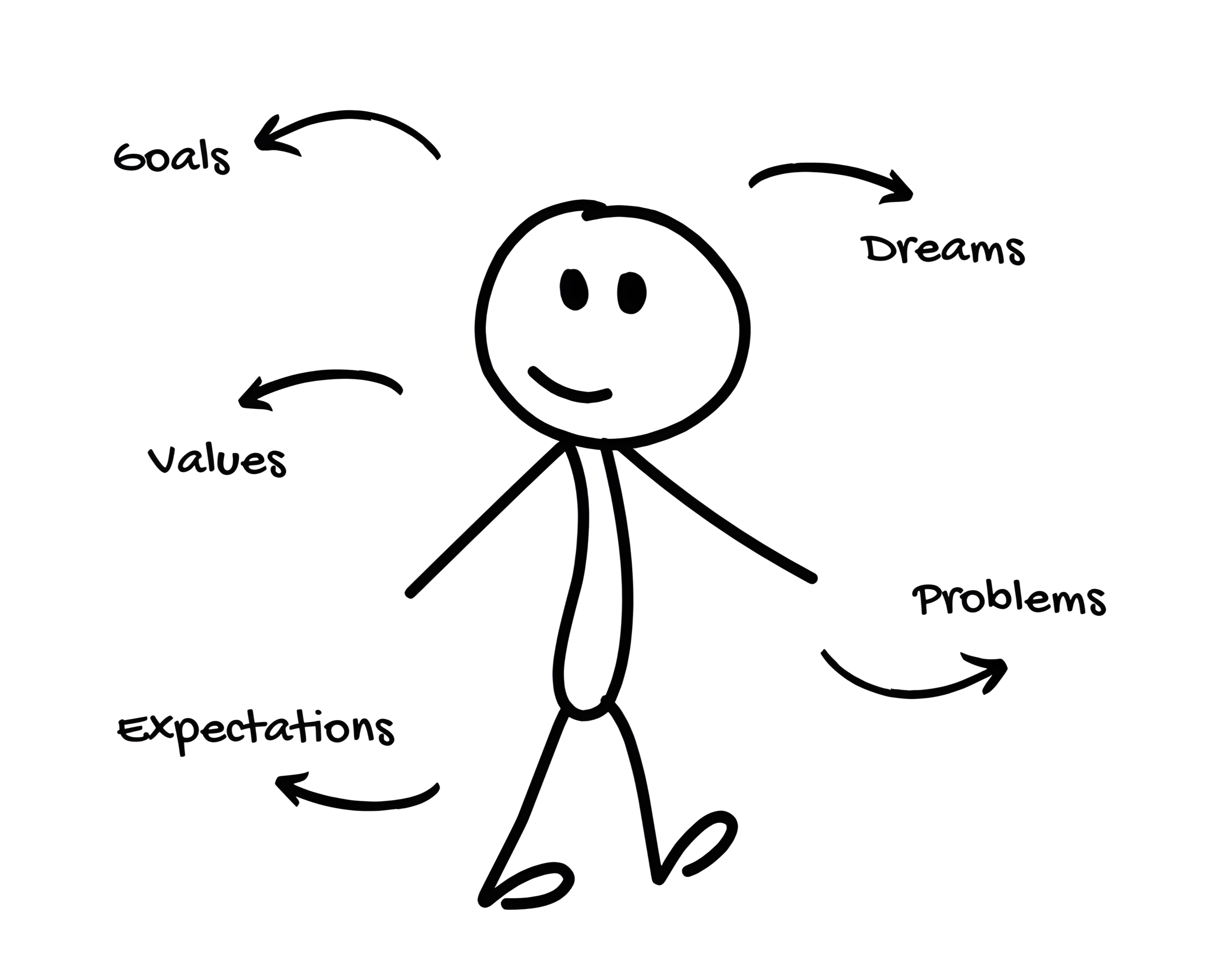
He has goals, dreams, values, problems that keep him awake at night, expectations for his life and so much more.
The last thing someone needs is an advertising message. And if you think about this, it makes sense, but if you’d known how many marketers don’t understand this, you’ll be shocked.
You simply can’t just shove someone your ad in the face and expect a good response. So, before you can start writing your message that will resonate with your reader, you need to understand him.
- What are his goals? His values, dreams. And also, what are his problems?
- What keeps him awake at night?
- What problems does he suffer from?
- What attitudes does he have? Religious, political, social, and economic-wise?
- What are his hopes and dreams?
- Does he have any prejudices regarding your product and/or industry?
Get this right and then you can start researching what your ideal customer uses. In 99% of all cases the market is already using a similar product or service that you offer.
So, you need to find out what works, what not, what the experience of solutions has been like and what the market likes and dislikes.
You’ll find it out by reading a lot of reviews and visiting forums. You may uncover horror stories about existing solutions, bad experiences and also great encounters with them.
In fact, you should take notes about the messages that keep coming up over and over again. What are the problems they try to solve? What keeps them awake at night? What do they crave, what do they deeply care about?
If you know this stuff. Then you know what you need to say to resonate with them. So that your sales message is relevant to them.
The goal is to get a “Hey! That’s exactly how I feel!” when your audience reads your messages.
The Buyer Journey Approach
Great, so you know what your audience is thinking. Now there is still one step missing before you can even think about a marketing strategy.
For what journey part do you write the message? Journey part? There are five individual buyer journeys. Crafted by Eugene M. Schwartz decades ago in his book Breakthrough Advertising.
The idea behind it was that not all people think the same when they read your message.
What I mean by that, have you ever tried to sell someone your product and the answer was “I don’t need that right now”? Have you tried limited time offers and discounts that should have worked according to experts, yet they failed miserably?
If so, then you fall into the trap of not knowing the buyer journeys.
There is one single rule that you must obey when it comes to marketing.
Join the conversation that is the most
present and valuable in his
mind at that moment.
Get this right and you know more than most marketers I know. And this isn’t an overstatement. I truly mean that.
If your ad or in general your sales message is not relevant for your reader, then why should he read it?
If someone knows that he has a particular problem and is looking for solutions, do you think it will help if you start to dramatize how bad it is?
No, he knows his problem and wants to solve it badly. Don’t tell someone what they already know. And don’t tell someone what he doesn’t want to hear right now.
How can you do that?
Whenever you write your advertisements, your landing pages, or your content for social media, whatever you do, ask yourself this one question:
“What is the most present and valuable conversation in the mind of my reader?”
Nothing else matters. I won’t go into detail about the copywriting aspect here.
Yet there is one thing I can promise you. If you know the conversation that your potential reader has in his mind right now, you’ll have no problem connecting with him through your words.
It’s not about getting attention in the sense of getting attention. Good luck trying that out. People focus too much on standing out, being interesting, thinking outside the box and all the other clichés that you hear in the advertising industry.
To have success with your ads you must communicate the value of your product, so the readers see the value of what you’re promoting and decide to take action.
These are the principles why some advertisements work, some do not, and most people do not know why.
And you can tie it back to the relevance of your message. The message. Your sales copy.
Whether it’s in the ad, the blog content, or on social media. If it’s not relevant to your reader, then he will not read it.
It’s simple as that. But if you know what’s happening in the mind of your reader at this very moment, you can build a connection that is relevant for him. Hence, he will listen.
You must communicate the right message at the right time within the right media. And you do this by joining the conversation that is the most present and valuable in his mind at the moment he will probably read your message.
Now, let’s find out what happens in the mind of people throughout the different stages of their buyer journey.
Why? Because each stage will have a different relevancy. You know by now that you need to join the most valuable and present message of your readers. If you don’t know this message and can’t build a – figuratively speaking – bridge to their mind, your efforts will fail.
How does the journey look like?
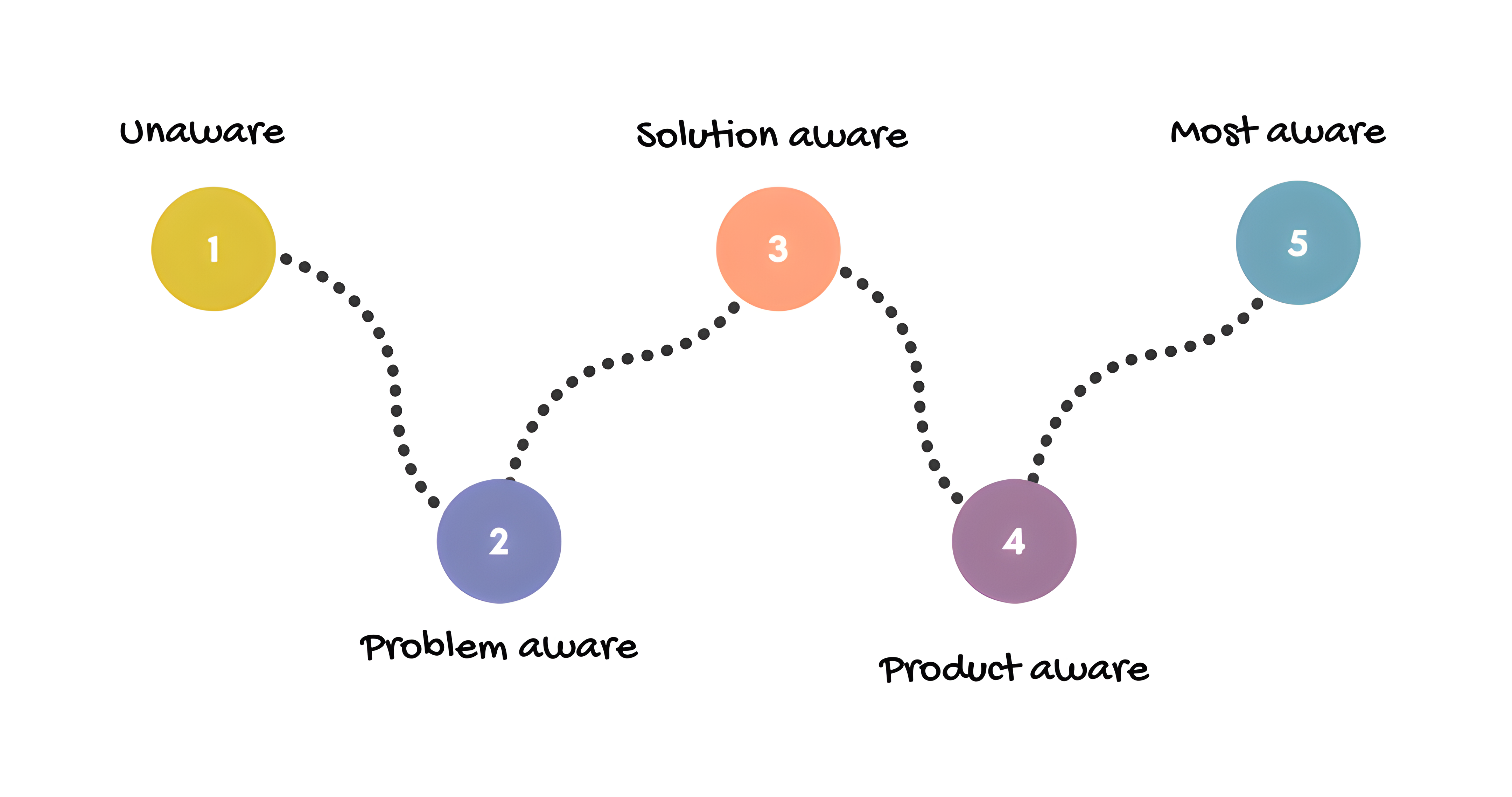
These stages were defined a long time ago by the copywriting legend Eugene M. Schwartz.
If you haven’t read his book Breakthrough Advertising, I highly encourage you to do so. It worked decades ago and is still more than relevant today.
And still most marketers I know don’t know these stages and just write marketing messages purely based on a customer avatar. While that is a great start it hinders the effectiveness of your advertisements tremendously.
Unaware
They are unaware of their problem. They don’t even know that they have a problem. Needless to say, if you try to sell them a solution it will fail.
Someone who is overweight but doesn’t think that he needs to lose weight.
So, what should you do? These people don’t care about you, nor the value you could provide for them. So, you better keep it quiet. There are many marketers who ignore unaware people. And the reason is quite simple: It’s hard to sell them something.
This is why you should not sell anything, nor promise. Rather inform him that he may have a serious problem and that you can help him. Even a limited time offer will not work because they are not interested in purchasing.
If you can build a relationship from the beginning and guide him along his way, you have no problem asking for the sale later.
So, what is the best way to connect with those people? First of all, you need to make him clear that he has a serious problem due to him being overweight. Go on and reveal the source behind this problem and present him with a mere concept of the solution.
And then? Give him a frictionless way to request more information. The best approach here is to relate with him through stories, myths, and vivid statistics.
Problem Aware
These are people who know that they have a problem and want to solve it. You don’t have to go miles to explain in a subtle manner that they have a problem. They know that.
But the thing here is that they are not interested in any specific kind of product or service yet.
Someone who knows he has health problems due to his overweight.
He is conducting quality research. He wants to learn about his problem and how it can be solved. If you offer him a product in this stage, ramble about how great you are – your ton of social proof – and how superior you are, he will ignore it and toss the ad away.
He doesn’t want to hear a sales pitch; he needs information and guidance.
Search Ads are often mentioned for this stage because they work great. People who search for ways to solve their problems can be easily found with Search Ads. But don’t get too focused on keywords, and search ads here. Such people can also be reached on blogs, in diverse Facebook Groups as well as offline in the right magazines.
What you want here is to collect their contact information by offering valuable resources that address their problem. Address the problem in such a way that your customer realizes how badly they need the solution.
Solution Aware
Your prospect is done with his research in this phase. He understands his problem and how crucial it is to solve it.
The overweight person decided to buy the best weight-loss supplement.
He also knows the various kinds of solutions.
Various kinds?
Yes, if you’re selling weight-loss supplements e.g., to overweight people you have more than just other supplement companies who compete against you. You also must deal with gyms and coaches who are selling a different kind of solution to the same problem: weight loss.
The challenge here is that such people have made their mind up. They have a specific price in mind and what specific ingredients the supplement should have.
You can’t change his mind. Never ever try to do that. What you want to do here is to help him to decide between all available options.
What falls into this category? Comparison guides for example. A breakdown of your product against other well-known competitors. If you can offer a demo or a free trial, do it. Provide customer testimonials, anything that will help him to conclude his research.
People here have a fundamental need for validation and reassurance. They don’t want to purchase something that could make them look like a fool. Subconsciously these people want to know if purchasing this product will make them smarter, better or more superior than others.
Ultimately, they want to find the answer to the question of whether this solution is right for them.
What does this mean? People in this stage have decided to settle down for a specific product. Let’s take as an example a weight-loss supplement. They are looking for the best weight-loss supplement.
This is why they need the answer to these questions “Is this right for me?”, “Which is better?” and the most important “Will buying this make me better, smarter or more superior than others?”
The thing is every business says, “we have the best product or service.” You do it too probably. And you know that your competitors also do it. But can you answer the questions they have?
Find out what best means for your ideal customers. Give them all the information they need. A transparent breakdown of your features and benefits, stacked against competitors. If you do something different, tell them why. The more proof – at best social proof – you have the better.
And then argument why you are the best by providing all necessary facts they need to conclude their research and choose you over your competitors.
Product Aware
People here have narrowed down their decision on a specific product. He knows the product but doesn’t yet want it.
The overweight person has found the best weight-loss supplement.
This is where you need to make the right offer and present your brand as the best. But please don’t just say “we are the best”. That doesn’t work anymore. Define “best”.
Present them your unique selling points, show your social proof, customer reviews, case studies, etc.
People generally here need an incentive to purchase. This is where you would classify discounts and special deals. Reinforce the desire for your product and show him how it will help him to solve his problem.
The bulk of all advertising happens here. You don’t need to educate them about a problem, about solutions, they know that. They’re past that stage. The overweight person has found the best weight-loss supplement. He is aware of the benefits he will experience with this very product. And he knows what problems he will solve with it.
So, don’t talk about problems and solutions. Talk about your product. Tell him why he should choose you over all the other products that are out there.
To be exact, here is what I’d recommend doing when writing advertisements or sales copy in general. Also valid for product pages.
First of all, show them why you are superior. Don’t just list features, prove why competitors fall short. A good example that I always see is “We have the best customer service” So, everyone says that. Does this mean your competitors have bad service?
State it like this “Our support team responds in under 60 seconds, 24/7”
Now this is a case of superior customer service.
Then, make the purchase decision a no-brainer. You know you should make the offer and name the price. Here we use superb discounts paired with money-back guarantees if possible.
For example, “For the next 48 hours, get 20% off AND a free lifetime warranty” – this is a tremendous deal.
And the last thing I’d recommend is to always sharpen their vision of your product and how it will satisfy their needs. Think back to our imaginary Glowing Skin care brand. You’ve written a great ad, and you bring the traffic to the product page.
Instead of “Our skincare gives you glowing skin”, rather say “Imagine waking up to smooth, radiant skin—without makeup. Our serum reduces wrinkles by 42% in 30 days!”
It goes without saying… but you always need to be specific and as exact as possible when writing sales copy. This principle must be applied to all marketing stages.
Most Aware
The overweight person is ready to purchase the weight-loss program.
They are ready to make the purchase. Make the right offer and name the price. These are the people who are on your list, who know you, your business and what you stand for. They are no strangers.
Provide enough reassurance that they are doing the right thing.
Make sure that your purchase process is simple. Explain it if necessary and address any final objections they may have. FAQs on product pages, for example, are designed for these people.
What happens after I hit the purchase button? Tell them. Most business leave their customers in the dark. Don’t do that.
As always keep it as simple as possible for your prospects to purchase your product. You wouldn’t believe how many businesses are making it hard to get the product.
The Prism Model
People come to your business from different directions, some need to give right away, some need to yield. Some campaigns need to do the same. Without an intersection there would be chaos. In today’s world there are too many cars, too many reckless drivers. The same applies in advertising or generally speaking in marketing.
For you as a business owner – a marketer – this means you need to define your strategies and your tactics. Otherwise, they’ll crash, and your marketing will be stuck.
Personally, I found it to be easy to think about five distinct steps of marketing.
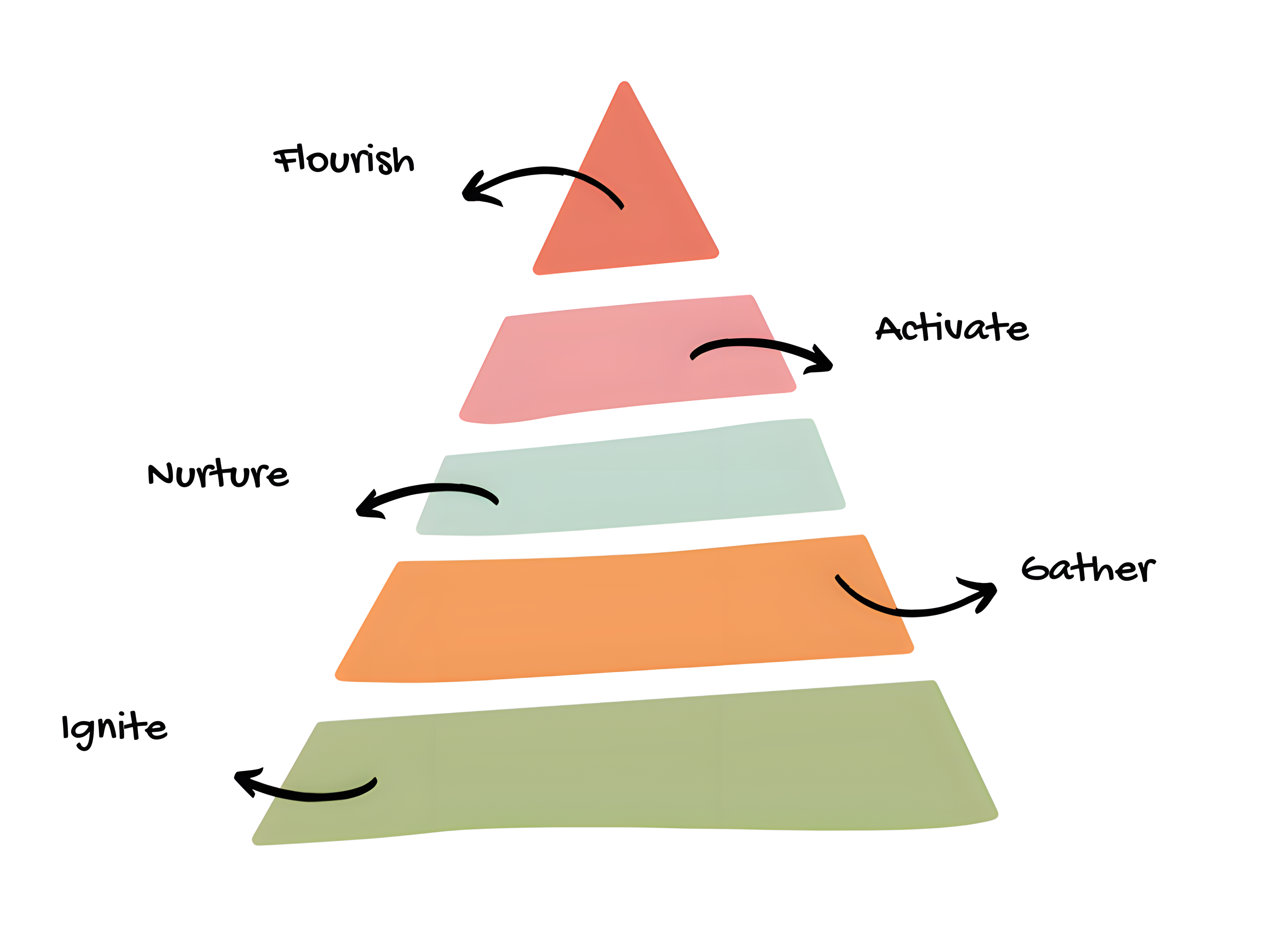
Everything you see, whether it is email marketing, PPC advertising, Affiliate Marketing, Sales Pages, Landing Pages, whatsoever, it can always be categorized. Always.
It will fall into either of these categories:
- Ignite (initial awareness & connection)
- Gather (collecting leads)
- Nurture (nurturing leads)
- Activate (turning leads into customers)
- Flourish (ensuring long-term customer satisfaction)
Imagine trying to find your way through a massive maze, but you have a bird’s-eye view while everyone else is stuck guessing which turn to take. This is what happens if you have the power to categorize individual marketing steps. It will also help you do plan your marketing ahead with a greater underlying strategy.
Throughout these stages I will refer to a beauty brand called Glowing Skin. So, it will be easier for you to understand what exactly is going on in these stages.
Ignite Stage
The beauty brand, “Glowing Skin,” wants to introduce their new line of natural skincare products.
They create a series of ads featuring beautiful models with glowing skin and run them on popular social media platforms.
The goal is to get your brand in front of your ideal audience. Making them aware of your existence and spark initial interest. You’ll use social media campaigns, search engine ads, blog content or anything else to capture the attention of potential prospects.
It actually isn’t from relevance what you use. Whether it is paid ads or free content.
In general sense you could say this is where all your advertisements fall into. Blogging, Search Engine Optimization whatever you do to be “found”. This is what the Ignite stage is about.
I specifically want to emphasize advertising here. Advertising in the sense of using paid ads. Whether it is pay-per-click, pay-per-impression, ads on other sites, in magazines whatever.
If you have lost money in the past with ineffective advertising, then let’s talk about it now. The effectiveness of your ad can be boiled down to three conditions. Get all three right, you’re golden, just miss one and the ad will probably fail miserably.
The Magic Triangle Approach
In the project management world, there is something called the magic triangle. Martin Barnes proposed this triangle in his PhD thesis in 1969 and has been used since.
It visualizes the costs, time and scope of a project. The inside of the triangle would be the quality of a project. It contends that the project manager can trade between constraints. A project can be completed faster by increasing the budget. While increasing the scope may require increases in budget and time.
Just like in project management, where balancing time, cost and scope are essential in maintaining quality, successful advertising depends on balancing relevant media, message and audience to achieve effectiveness.
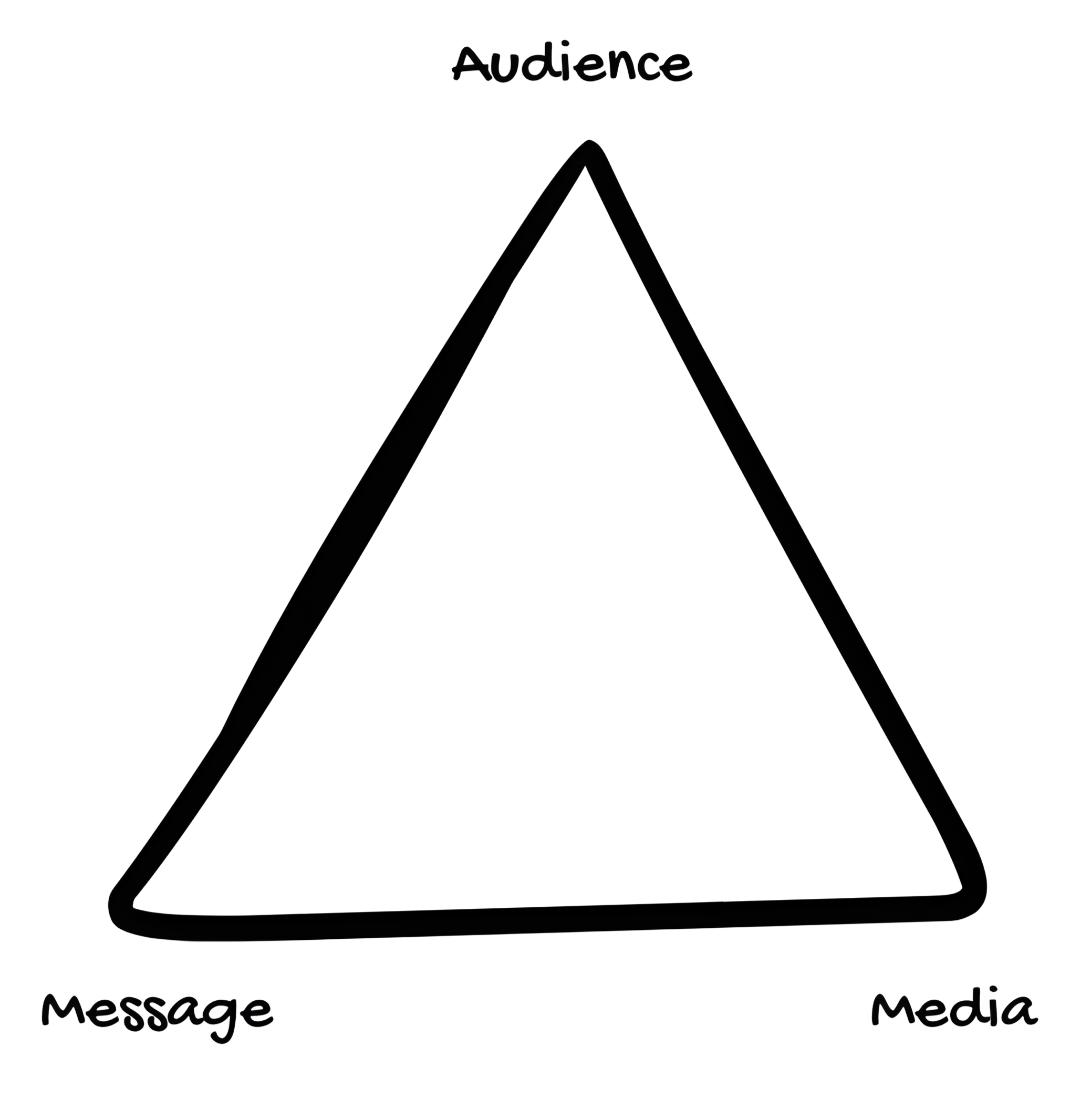
If you have the right message and audience but the wrong media, your ad won’t reach them effectively. If you have the right media and message but target the wrong audience (who will not see your message as relevant) the ad will fall flat.
And if you have the right media and audience but a weak message, the impact will be meager. If one of these three elements is off, the effectiveness of the campaign suffers.
Your job is to get all three parts right.
Communicate the right message (1) at the right time (2) within the right media (3)
This leads to the fundamental rule that it’s irrelevant where your ad runs. Whether you run a search ad, an ad in the newspaper, or on the radio. It’s meaningless.
So many people try to find out how to write search ads. Then, they decide to run some ads on Facebook. So, they search for information on how to write ads on Facebook that work. The same is repeated then for how ads run on Pinterest and so on and so forth.
Stop this. You’ll go crazy.
In the end it only depends on if you get the triangle right. Let’s talk a bit about each corner of the triangle.
The Relevant Audience
You know your audience if you did a great job in the research part we’ve discussed earlier. Know your ideal customer and know the market you operate in. With this knowledge you are able to write ad copy that is relevant for your customers.
The Relevant Message
Join the conversation that is the most present and valuable in his mind at that moment.
Based on the audience part in our magic triangle you should have a deep understanding of the market and your ideal customer. Knowing both parts will give you hints about what you need to write to connect with the reader of the ad.
The Relevant Media
The relevant media depends on your audience and the kind of message you want to use for your ad. Every media is different, different allowed copy length (think Google Ads, Facebook, etc.) and different restrictions.
So, if we take the example of a search ad and you use the keywords someone who is problem aware would use to research his problem then you’re good. If you know the blogs your audience is reading, then you can run the ads there.
They’ll probably be in the problem and solution aware stage. And you may encounter product aware people also.
In the end – again – it is not important in what media you run the ad. Based on the research you should know the appropriate buyer journey and what kind of messaging you need to resonate with them.
Gather Stage
Collecting leads involves creating an appealing message that resonates with your target audience, making them interested in learning more about your offer.
Glowing Skin creates targeted Facebook ads highlighting the benefits of their products for specific skin types (e.g., acne-prone, dry, or mature skin) offering DIY guides
I think you’ve been bombarded with a ton of information about this stage. The ominous lead capture stage. The money is in the list and all that other rubbish regarding this stage.
The common idea is to provide information for free. A book, a newsletter, a case study, or the DIY guide. Then you build the list, shoot an email, ask for the sale.
The result? Horrible. Almost no sales. You’ve been marked as spammer, people unsubscribe. While the idea is great behind this strategy of lead generation. If you do it this way, it’ll fail. That’s why it is to be relevant for the people on your list.
Where do I want to go with this? I am talking about the quality of leads. Not the quantity. It does not matter how many leads you acquire, if none of them buy.
The issue is that many businesses attract freebie seekers with this strategy. People who have no intend purchase. Your job is to quickly weed them out.
It’s a fact that you will always have people who will never buy. It’s unfortunate, yes, but that’s just how it is. Not everyone will become a customer.
So, when you offer free information to get people on your list you need to ask as soon as possible for a sale. Completely fine if it’s a low-cost product and you lose money upfront. Later when we talk about the KPIs you will see why it is okay to lose money to acquire customers.
Let’s take a look at the follow-up stage now and why the money is in the list is in most cases rubbish.
Nurture Stage
Nurturing leads means providing value and building trust through email follow-ups or other communication channels, ultimately giving prospects the opportunity to acquire your offer (e.g., make a purchase).
Glowing Skin sets up an email marketing campaign that feature product tutorials and special promotions
Here you want to build trust through consistent follow-up. Mostly achieved by email marketing campaigns, personalized content and social media engagement. You may also use remarketing campaigns through Google Ads, Facebook, etc.
Whatever you do, at this stage you want to maintain regular contact with your leads. If we go back to the Gather stage. The brand Glowing Skin has offered DIY guides, remember?
Now, we have contact information about those people and depending on what DIY guide the downloaded (acne-prone, dry or mature skin) we need different marketing campaigns. Again, we must be relevant.
Let’s say Glowing Skin offers a low-cost sample of a face mask for acne-prone skin. They use this offer and send the email to this specific list. To the list of acne-prone people not to the people who suffer from dry skin. Then the message wouldn’t be relevant.
The idea is to ask for the sale as soon as possible.
You don’t need to sell your most expensive product here. Offer something that will complement the free information. Offering a sample for the DIY guide is an excellent way to weed out the people who will not purchase. And by that, I mean that there always will be people on your list with no intend to buy. You need to get rid of them as soon as possible.
This also means you will inevitably lose some people on your list – and that isn’t just okay, its necessary. You don’t want to waste your time with people who don’t intend to purchase from you. So, if you can, offer a low-cost product to those people and if they don’t purchase, follow up, but if they don’t buy after the third email, get rid of them.
Yes, this may sound hard. But the issue is that too many business owners waste their time with a huge list of leads that are purely there for free information. They don’t want to buy; they want free stuff.
Activate Stage
Turning leads into customers is all about creating an irresistible call-to-action that prompts prospects to take the desired action.
Glowing Skin creates a limited-time offer (e.g., 20% off first-time purchases) for new subscribers who sign up for their email list
With the first three steps you should have a good audience that knows you as a brand and what you stand for. Your offers. Your prices. Your job here is to ask for the sale. Present them your best offer and provide enough sales copy to tackle their objections.
People here need foremost reassurance and a smooth, simple purchasing process.
Flourish Stage
You got a sale. What is more important is that you have won enough trust that someone was willing to purchase your product.
After acquiring your product, it’s essential to ensure that customers are satisfied and remain loyal through post-purchase follow-ups or loyalty programs.
Glowing Skin sets up a loyalty program that rewards repeat customers with points redeemable for free products or discounts on future purchases.
This takes enough time and costs money. Still so many businesses don’t do anything to make sure that their new customers are satisfied. Do you send them a warm “Welcome!”, or “Thank You!”?
Again, here it’s a good strategy to reassure them that they did the right thing. You want to maximize customer retention and encourage repeat purchases. Get testimonials, collect feedback and in the best case perhaps event critic what you could do better.
The Marketing Intersection
If you tie together the buyer journeys and all five stages or buckets of marketing, you can see the picture.
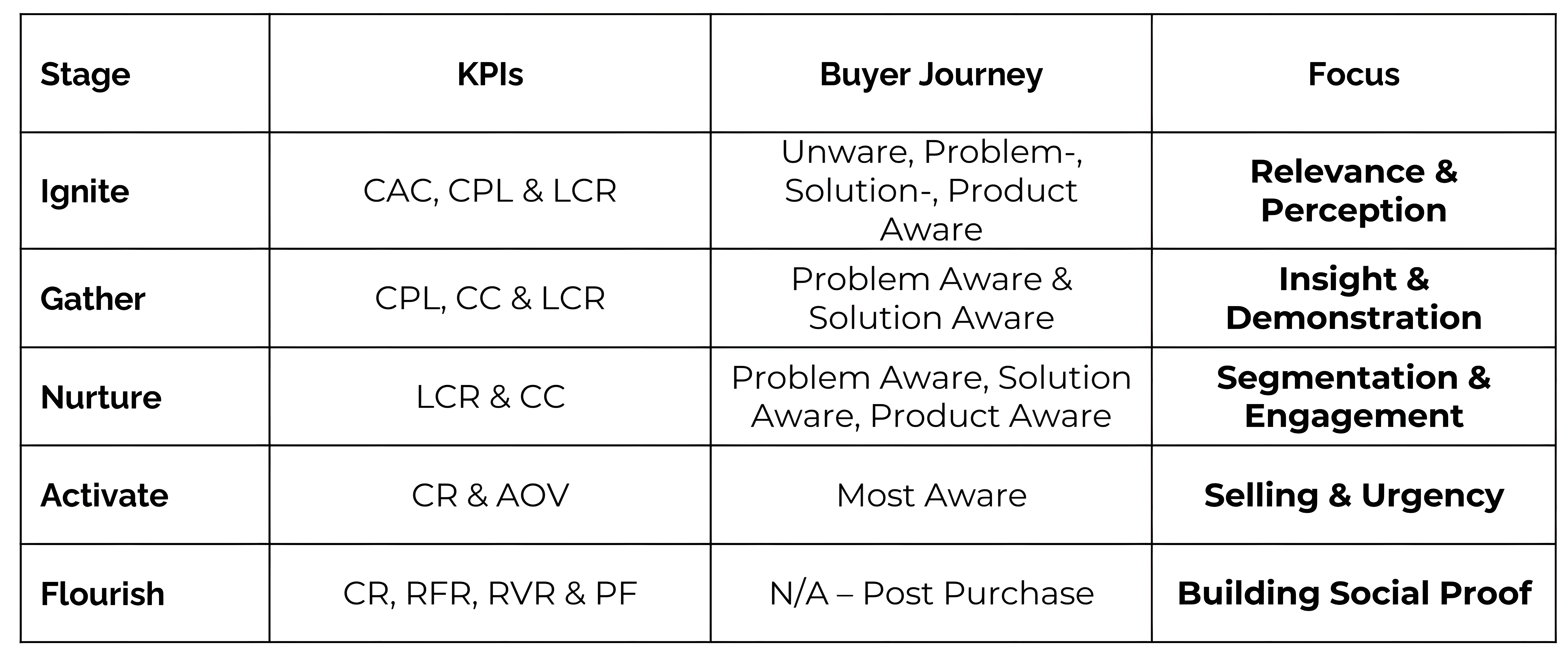
You see, each stage can be controlled by specific KPIs. Each stage will have a focus, one or two main objectives of what you want to achieve and what buyer journeys you’ll encounter there.
Over the next few chapters you’ll see the KPIs and also what campaigns try to do in in each stage.
The reason why you should think about marketing like a intersection is to escape this thinking
I just need more sales. I need to keep this within our budget. I can’t afford that. If this doesn’t produce at least $X within next month, I’ll drop it for good.
You better drop this behavior right now.
Imagine you’re stranded in the middle of the ocean with just one flare. One shot to catch the attention of a passing ship. If they don’t see it, you’re out of luck, hoping for another miracle.
That’s exactly how many business owners treat their marketing.
They fire off a single message, cross their fingers, and pray for a quick cash injection.
Without a system, every marketing effort is a desperate SOS. If one attempt fails, you’re scrambling for another quick-fix solution.
You end up targeting customers who are either price shoppers or people who need a ton of convincing both of which drain your profits.
And we don’t want that.
So, let’s start to combine the laws of human nature with the five stages of any successful marketing system and create our intersection.
And I’ll show you what that means for your business, how you should interpret it and what to do with your advertising dollars.
For easier understanding let’s take our imaginary brand Glowing Skin and take a look at what they will do at each stage, for each buyer journey.
Ignite Intersection
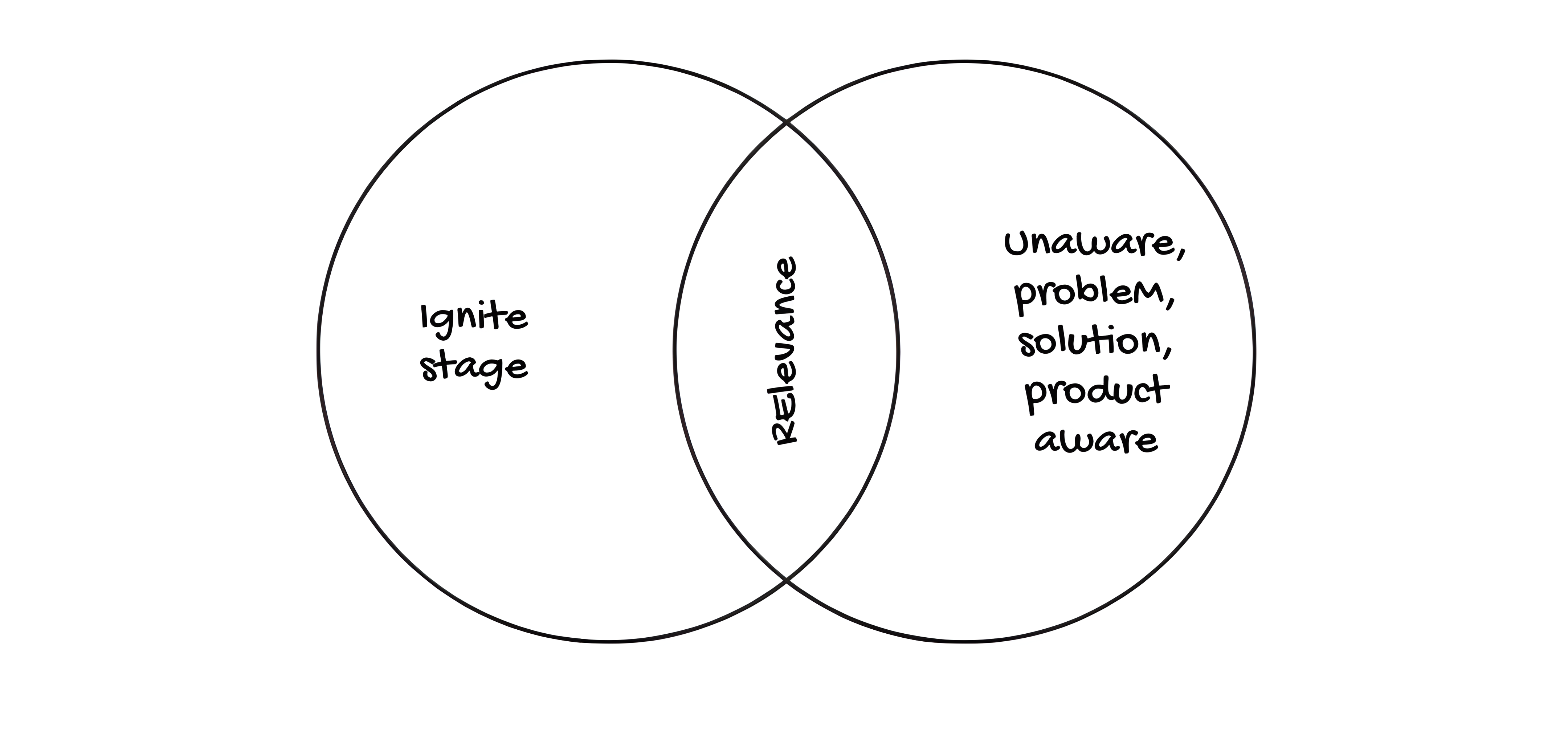
In the Ignite stage you can write advertisements for all stages of the buyer journey. Whether it is for unaware, problem, solution or product aware prospects.
The relevance of your advertisement is the important part here. Don’t try to write an ad that explains the solution but is then exposed to people who are already solution aware.
Choose your channels wisely. Don’t forget that you must communicate the right message at the right time within the right media.
Gather Intersection
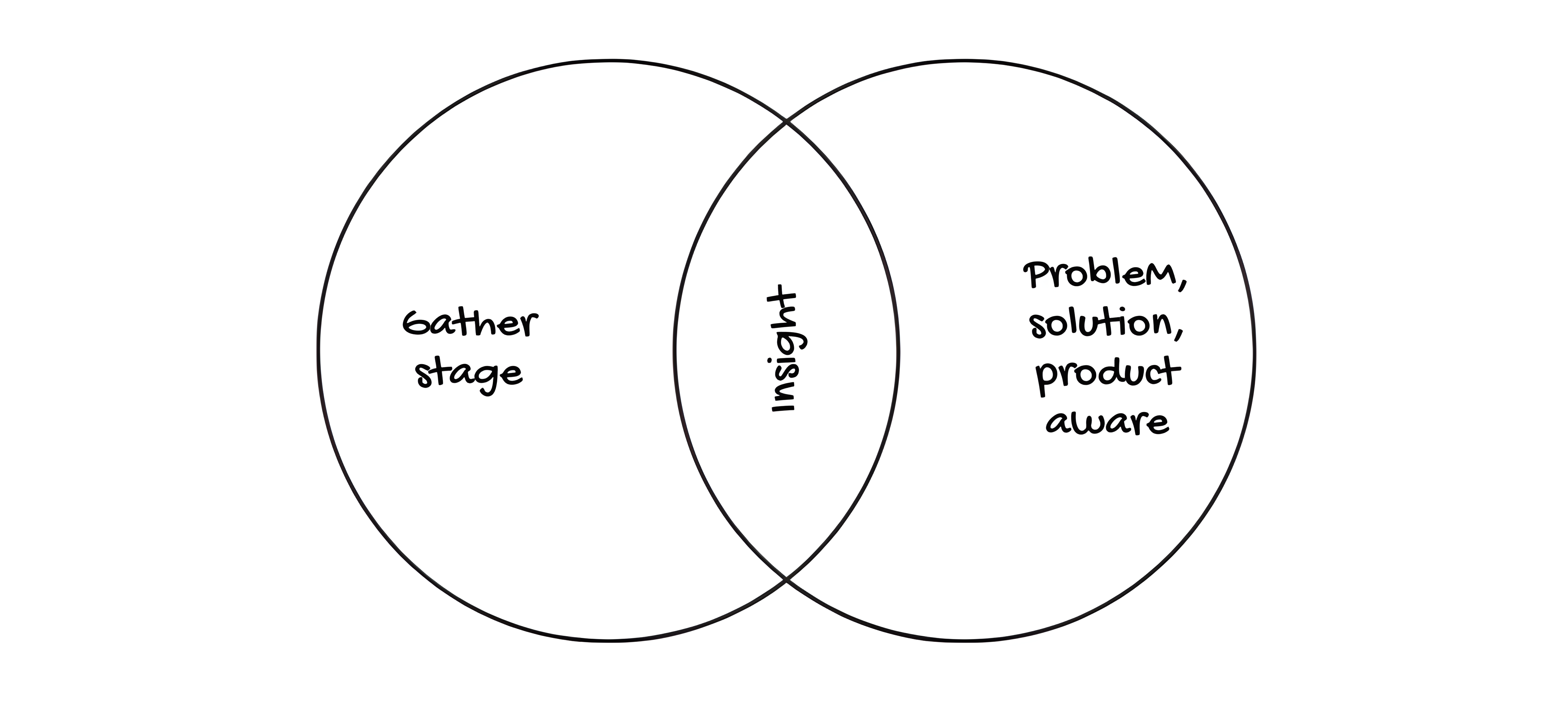
In the Gather stage you will probably target in most cases problem aware people. These people know their problem and are actively searching for solutions.
Your job is to collect their contact information by offering valuable resources that address their problem. Offer comprehensive guides or eBooks that delve into the problem and potential solutions. You may provide an exclusive discount or special offer for those who sign up or download your information.
For the solution aware people, you must use a different strategy. As you remember, these people want reassurance. They have made their mind up regarding the benefits of your type of product. And they have decided what they believe they should pay.
Showcase how your product is superior and may fit into their “best” category. Provide a free trial so they can inspect your solution on their own.
If you run an e-commerce store offer, if possible, a free sample of your product. Use detailed case studies and testimonials that illustrate real-world examples of how your solution has effectively solved similar problems.
Nurture Intersection
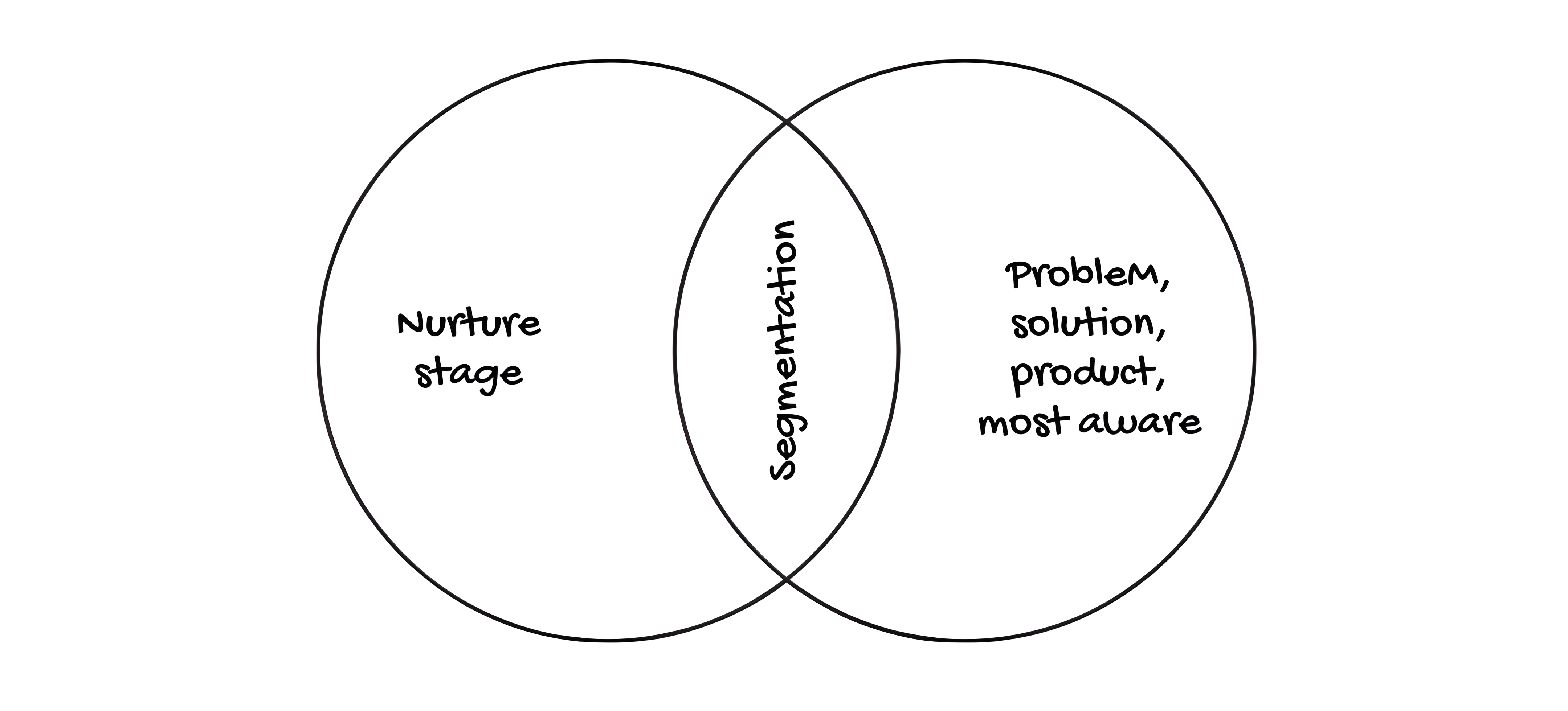
E-Mail marketing is the puzzle part that would fit in here. Based on the buyer journeys you need different lists. You can’t send the same emails to different stages. Someone who is problem aware must be treated differently than the solution aware people.
You will probably also have a different list for existing customers, as well as for people that are in the most aware stage.
They all need different sales copy. Different offers. A different approach. This is the crucial part that many marketers ignore. They have a mixed list of problem- and solution aware people. Some emails work, some don’t, and they never know why.
You need to be relevant, remember?
The right message, at the right time within the right media. The media is your email. Now you still need the correct message for the conversation that is currently the most important and valuable in their mind at that moment.
Another part here is remarketing. People who came to your site and left. With Google and also Facebook you can use remarketing advertisements to bring them back to your site and try again to get their contact information.
Activate Intersection
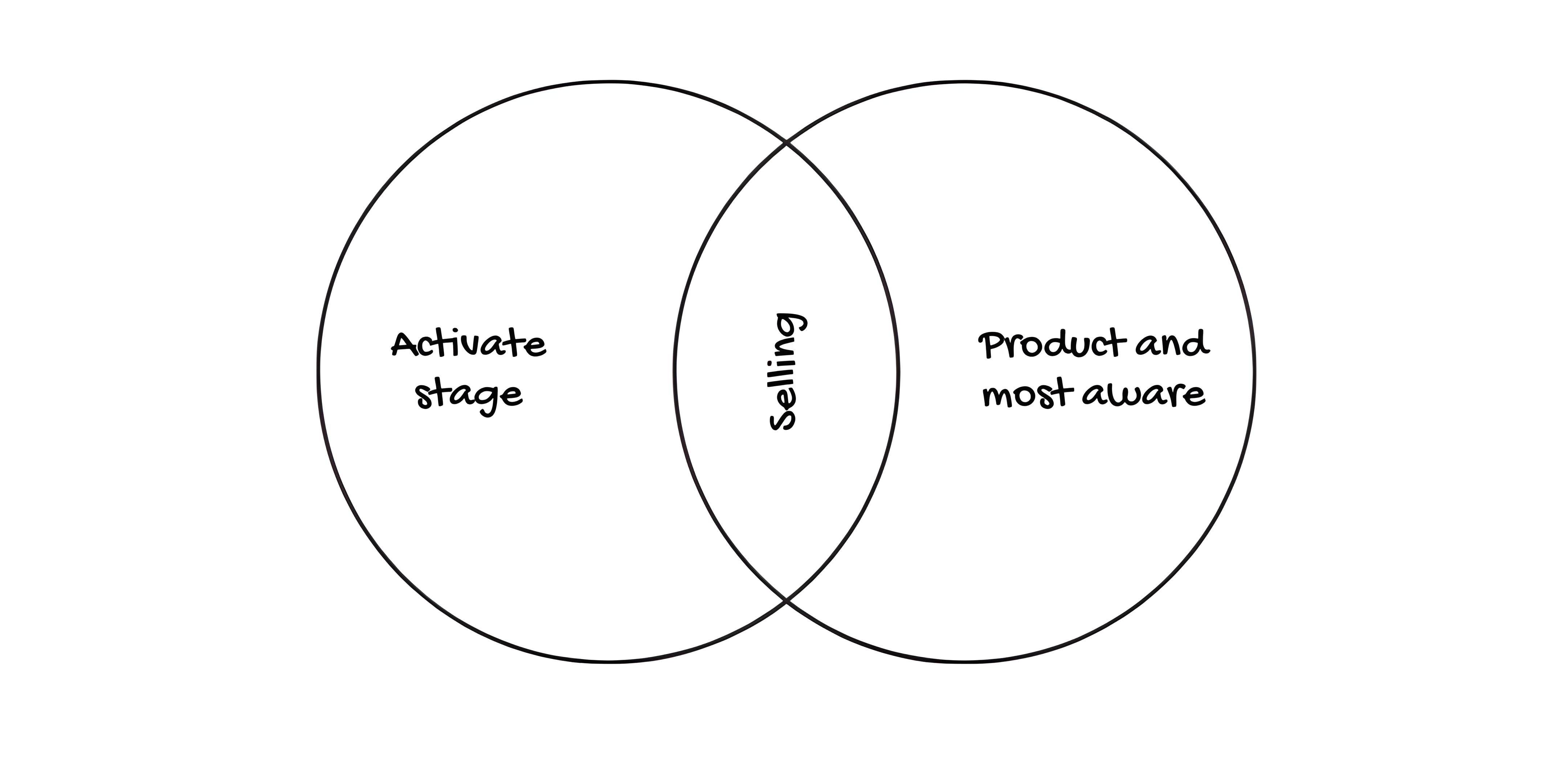
This is the conversion part. You ask for the sale, it’s simple as that.
In this case the people are aware of your product (product aware buyer stage). Yet, it can also happen that solution aware people come to your product page through advertisements or word-of-mouth marketing and purchase your product.
Can it happen that problem-aware people buy? Yes.
It all depends on what kind of product you have as well as the price. “Cheap” products, anywhere under $100 don’t need a lot of justification. Higher priced products often need more sales copy, a longer FAQ section, more social proof, money-back guarantees and so on.
If you connect with unaware as well as problem aware people through advertisements, gather their information, nurture through valuable content and you will have a high conversion rate. Running paid ads to your product page directly can lead to low conversion rates if you don’t know in what stage your visitors are.
One thing here is important. Provide reassurance and a smooth purchase process. Address objections, provide guarantees if possible and all in all have a strong offer. People don’t want to make a purchase that will make them look foolish. So, you need to minimize the perceived risk.
This is why you see FAQs on product pages, the display of security logos (safe purchasing process, TLS encryption, …), money-back guarantees, etc.
Flourish Intersection
You got a sale. What’s more important is that you earned the trust of a fellow human being. And you got yourself a customer. Someone who believes in your values.
Reassure their choice. Not only appreciate their sale but also remind them why you are the best solution. Move them to your customer list. Build a lasting relationship that encourages repeat purchases. Ask for referrals and testimonials in exchange for discounts and other incentives.
Getting a customer is hard, yet so many business owners ignore their current customer base. Keep in touch with them, if you launch a new product, announce it, give them a discount. Build a loyalty program, introduce VIP points, etc. Make them feel valued.
This is where the Customer Journey begins. Only then. Before the purchase we only need to talk about the Buyer Journey.
Key Performance Indicators
Each stage of our intersection has its own metrics you must track. Their own Key Performance Indicators if you prefer this name.
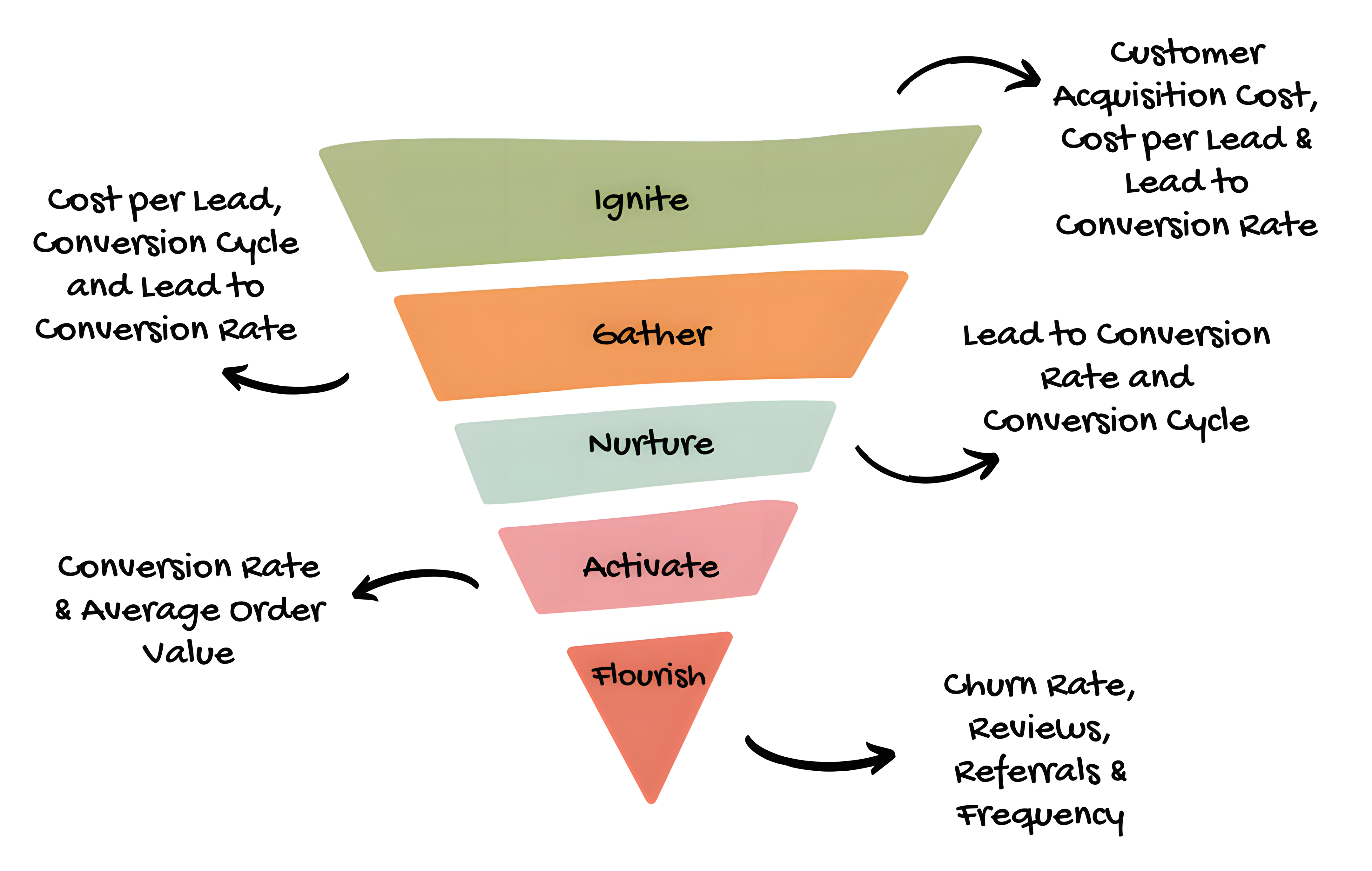
You can track dozens more and become lost in a sea of numbers. This is why I only focus on these metrics. These provide all the answers you need to judge how good your marketing is – not based on your gut feelings – but based on numbers.
And, frankly, numbers don’t lie. And honesty is what you need when deciding what to do next, where you can improve and more importantly, it helps you to become a better marketer.
Moreover, it gives you authority among other business owners and marketers who may try to coax you to do this instead of that. It just feels amazing to know the numbers because you can optimize like a genius.
Don’t believe me? Just ask someone what their Conversion Cycle is, or in which channel they have their lowest customer acquisition cost, and you’ll see their helplessness.
I will go over each piece and show you the metric, why it matters and how you can track it.
Ignite KPIs
When you run advertisements in a broader sense, you want to track three metrics.
- Customer Acquisition Cost (CAC)
- Cost per Lead (CPL)
- Lead to Conversion Rate (LCR)
Customer Acquisition Cost
It’s the total amount of money you spend on marketing and sales efforts to gain one new customer.
The idea is that the CAC is always lower than the revenue you make from a new customer. There is one exception to this rule. If your customer has a high Lifetime Value (LTV) then your CAC can be higher in the beginning.
The LTV? How often does a customer purchase from you and how long does he stay with you on average? If a new customer comes to your business and purchases on average four times a year, with an average price of $19.99, your LTV for one year would be $79,96.
And if we know that this is the average for around four years. We know that a customer from a particular channel will net us in four years $319,84. Now, our CAC would be ideally lower than $319,84 of course.
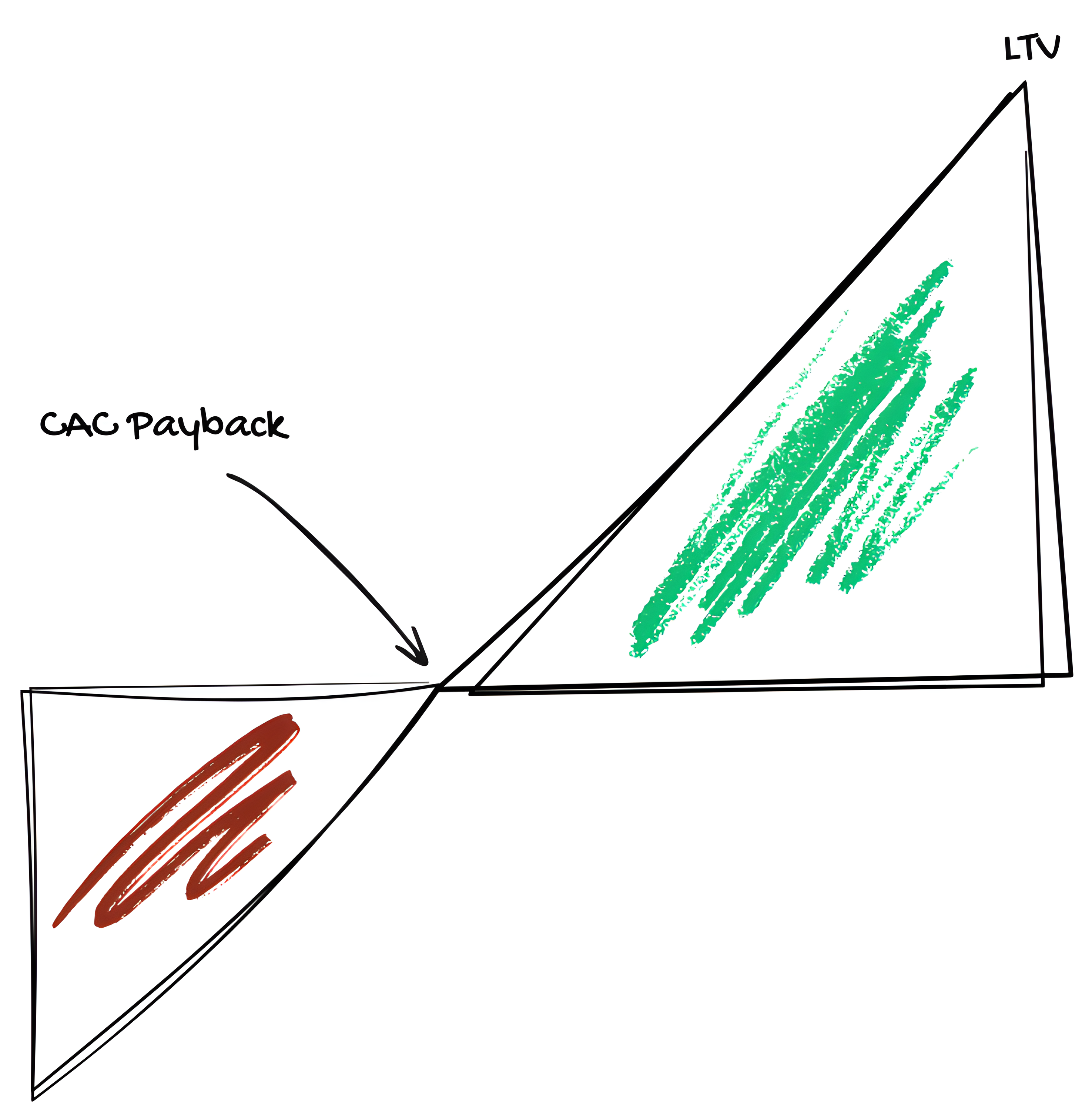
Concerning pay per click advertisement you will often have a high CAC. Depending on the keywords and your industry. The costs are sometimes lunatic, I know.
Yet, if you know your LTV then you can afford to invest more, not because you think you can, no, because you know it is based on numbers.
The CAC is calculated through.
CAC = (Total Marketing and Sales Costs) / (Number of New Customers Acquired)
So, if you spend $10,000 on marketing and sales and acquire 100 new customers, your CAC would be $10,000 / 100 = $100.
Cost per Lead
You invest your money in acquiring leads (potential customers) in the hope they will eventually purchase. This metric is especially important because people don’t immediately purchase, rather make an account, sign up for a newsletter, or download some sort of informational content.
It wouldn’t make sense to spend more on leads than what they’re worth. You need to ensure that the cost of acquiring a lead makes sense in relation to the potential revenue that lead could generate.
In other words, the CPL can be interpreted as the cost-effectiveness of your leads. Just like the CAC we can’t look at it in isolation.
You need to consider your CPL for all advertising campaigns in conjunction with the LTV and the Lead to Conversion Rate to understand the full picture.
Cost Per Lead (CPL) = Total Marketing Spend / Total Number of Leads Generated
So, if you spent $1000 on a marketing campaign and it resulted in 100 leads, your CPL would be $1000 / 100 = $10. This means, on average, you spent $10 to acquire each lead.
If I track CAC why bother with CPL?
Your Cost per Lead is a component of the CAC. Don’t confuse these two metrics. The CAC is the full cost of acquiring a customer whereas the CPL tells you how much you spend to get a lead.
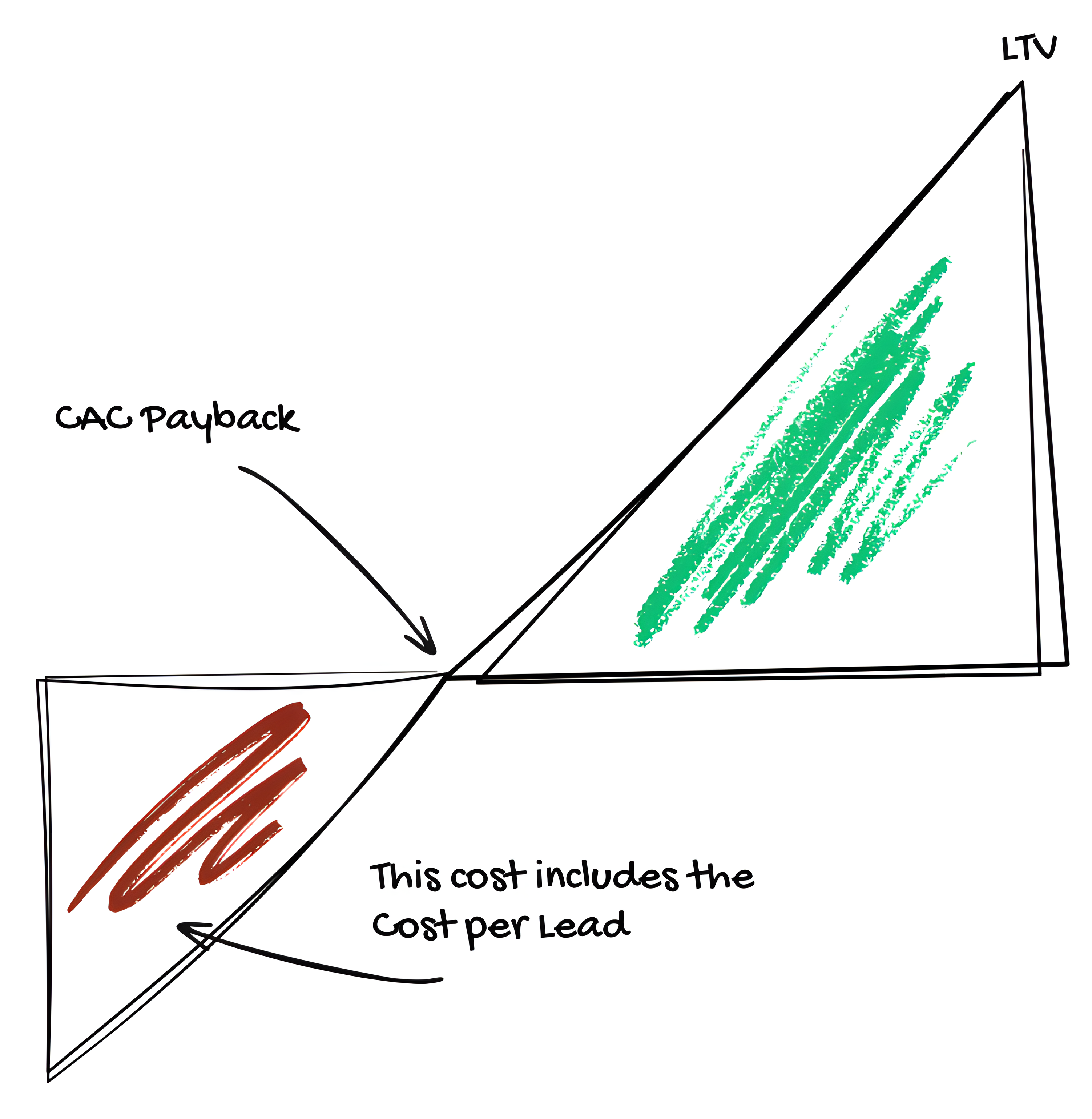
Since not every lead converts into a customer, your total CAC includes CPL but also factors in conversion rates and additional sales costs.
So while CPL is a useful metric, CAC gives you the full picture of what it actually costs to acquire a paying customer.
Lead to Conversion Rate
The number of leads is irrelevant if you don’t know this number. You want to maximize the Lead to Conversion Rate. This is especially important if you have a high CPL.
It also helps you to identify the quality of your leads. It gives you a definite answer if you attract the right kind of leads who are genuinely interested in your product or if they are just freebie seekers with no intent to every purchase from you.
But it can also mean that your Nurture part is bad. Mixed up lists with different buyer journeys and the wrong (not relevant) content may be send to them. Hence a low LCR.
Lead to Conversion Rate = (Number of New Customers / Number of Leads) × 100
So, if you had 1000 leads and 250 of them became customers, your Lead to Conversion Rate would be (250/1000) X 100 = 25%. This means you successfully converted 25% of your leads into customers.
Gather KPIs
Here the focus should be on
- Cost per Lead
- Lead to Conversion Rate
- Conversion Cycle
CPL and LCR give you the answer if your lead generation process is of good quality. As well as if your follow-up sequences are aligned for each buyer journey.
Conversion Cycle
This number gives you confidence in cashflow planning. How long does it take that a lead becomes a customer? 30 days? 60 days?
If you know this number, you can plan with your marketing budget. The number will be higher or lower depending on the channel. This is a quite interesting observation. I’ve found that some leads purchase sooner than others purely based on the medium I acquired them.
A short Conversion Cycle means your leads are converting quickly, which is great for cash flow and business growth. A long Conversion Cycle may indicate that your follow-up process requires multiple touchpoints.
This isn’t necessarily bad (if you have a free trial e.g. of 30 days, or a higher-priced product that needs more “education”), but it’s important to ensure that a long Conversion Cycle still leads to profitable conversions.
Comparing Conversion Cycles across different channels can also show you which sources bring in faster-converting customers.
Knowing this number will also be important to forecast the revenue from specific marketing campaigns. We’ll talk about forecasting after you know all the important KPIs.
Conversion Cycle (CC) = Total Days of All Leads / Total Number of Leads
What is the meaning of days? For all leads track the date they share their contact information with you and the date when they purchased their first product from you. Add this number up for all leads generated and you have your average Conversion Cycle in days.
For example, you have generated 200 leads, and in total the time of becoming a lead, till the first purchase was 600 days your Conversion Cycle would be 600 / 200 = 3 days.
This means, on average, it takes 3 days for a lead to become a customer. Yes, it may be tiresome to track for all leads the day they became a lead and the day the purchased their first product, yet it’s worth it.
Nurture KPIs
For the Nurture part you solely focus on both Lead to Conversion Rate (LCR) and Conversion Cycle (CC).
It’ll show you how good you are with your follow-up with your different lists.
Activate KPIs
For the conversion part we track
- Conversion Rate (CR)
- Average Order Value (AOV)
Mind the context here. A “conversion” is the completion of a desired action. This action can and will vary depending on the goal of your campaign. It may be the purchase itself, signing up for a newsletter or downloading a piece of information.
For the Activate stage our desired action is purchase. There are dozens of courses and books for conversion rate optimization. Personally, I think if you did a great job in the previous stages your conversion rate is usually high.
If you send a limited time offer to the people on your list that are most aware, as well as solution aware it will be a high CR. Whereas the CR will be lower for problem aware.
Calculating the CR should be done with great attention to the details, otherwise you get a completely wrong number. Send the email, make your offer and make sure that you have a way to track the number of people who clicked on the link and then landed on the page. Utilize UTM parameters and good web analytic software. If you’re in the EU – or have visitors from there – don’t use Google Analytics for god’s sake.
To calculate CR, divide the number of conversions (e.g., purchases, sign-ups) by the total number of visitors or leads, then multiply by 100 to get a percentage.
Conversion Rate (CR) = (Amount of Conversions / Number of People Who Purchased) ×100
So, if your sales page had 1,000 visitors from the email campaign and 50 of them made a purchase, your conversion rate would be (500 / 1,000) × 100 = 5%.
Average Order Value (AOV)
Increasing the AOV is a surefire way to grow your revenue. Perhaps even double it. It gives you a deeper understanding of your customers’ spending habits. And it also provides you with an insight into how much revenue you can expect from a typical customer.
What you should consider is using upsells and cross-sells during the checkout. If you are an ecommerce business. Suggest products that may fit with the ones in the cart and often it’ll be added to the cart.
It’s a cost-effective strategy to increase your revenue without needing to attract more customers.
Average Order Value (AOV) = Total Revenue / Number of Transactions
For example, if your online store generated $10,000 in revenue from 200 transactions, the AOV would be $10,000 / 200 = $50. This means that, on average, customers spend $50 each time they shop at your online store.
Yes, it is almost irrelevant if you run a SaaS business. The AOV will always be the same if you don’t also provide paid support, or bonuses to increase the AOV. If you can come up with additional products that would make sense, then do it.
For most SaaS companies this metric is meaningless indeed because the AOV will always be the same.
This is the reason why you often see “price-per-seat” and all the other great ideas to increase the AOV by charging per seat or user. Using this tactic will of course increase the AOV.
Flourish KPIs
Now that you have your customers, you need some numbers to keep track of them. Don’t just count the number of existing customers. That’s pointless.
Track the following metrics:
- Churn Rate
- Review Rate
- Referral Rate
- Frequency
The first metric tells you how many customers you lose. The other two show you how good your relationship really is. Remember, word-of-mouth marketing always trumps anything that you say.
Getting referrals and testimonials (reviews) is your goal here. Anything that you can use as social proof is superb.
Churn Rate
Don’t get too caught up with this number. You need to see the big picture. Yes, the churn rate tells you how many customers you lost during a period of time. And while losing customers is always a bad thing – and must be investigated why – it might not be a serious problem regarding the churn rate.
Why so? If you can fill the water faster than the water is leaking out, then you might ignore it. Take a look at the churn rate in the context of the Lifetime Value as well as the Customer Acquisition Cost. This will show you if it’s a real problem or not.
Yes, losing customers should be make you concerned. But sometimes people leave just because they do. Because they no longer need your product. Or because they’ve changed. Thinking back to the weight-loss example. Why purchasing more supplements if I am happy with my current bodyweight and no longer want to lose weight? Then I’ll no longer purchase.
Churn Rate = (Number of Customers at the Start of the Period – Number of Customers at the End of the Period) / (Number of Customers at the Start of the Period) × 100
So, if you started the month with 200 customers and ended the month with 180 customers, your churn rate would be ((200-180)/200) × 100 = 10%.
This means that you lost 10% of your customers during that period.
Review Rate
As you may think, this number tells you how many reviews you get from existing customers. Getting reviews must be on your agenda. You can use them everywhere, almost for all buyer journeys.
And social proof always trumps your own sales copy. Or at least it can have a tremendous impact.
Review Rate = (Amount of Reviews / Number of Customers) × 100
For example, if you had 1,000 customers in a month and received 50 reviews, your RVR would be: (50 / 100) × 100 = 5%. This means 5% of your customers left a review.
Referral Rate
How many referrals did you get? Don’t underestimate the power of referrals. If an existing customer likes your product so much that he tells his friends about it and thus they purchase from you, then you did a great job.
Yet, too many business owners wait for it to happen. Don’t do that. Encourage your existing customers to tell other people about how great your product is. Reward them with points, VIP programs, discounts, etc.
Referral Rate = (Amount of Referrals / Number of Customers) × 100
For example, if you have 1,000 customers in a month and 50 of them refer at least one new customer, your RFR would be: (50 / 100) × 100 = 5%. This means 5% of your customers referred someone new.
Purchase Frequency
With this I mean how often do your customers purchase from you? It’s not a fancy metric and you can easily calculate this metric. It gives you a superb insight into the loyalty of your customers and it shows one thing clearly:
How good you take care of your
post-purchase marketing endeavors.
Getting a customer takes time and money. Still so many business owners then just stop. They think their job is done. It’s not. Now it’s time not to only say thank you but also keep in contact and build that relationship.
Taking care of customers is probably the most overlooked part of all businesses. Every business I know says it takes care of their customers. Do you?
Regular contact is crucial to encourage repeat purchases and to motivate your customers to write raving reviews and also recommend your business to their friends and family.
When you know how often customers purchase, you can better plan inventory, adjust marketing efforts, and forecast revenue. It also allows you to see which customer segments are most engaged and where you might need to work on increasing repeat purchases.
To calculate PF, divide the total number of purchases by the total number of unique customers during a given period. For example, if you have 1,000 purchases from 250 customers in a month, your PF would be:
Purchase Frequency = (Amount of Purchases / Number of Unique Customers)
For example, if you have 1,000 purchases from 250 customers in a month, your PF would be: (1,000 / 250) = 4.
This means that, on average, each customer makes 4 purchases in that month. This number can help you plan promotions, manage stock, and optimize your overall customer experience.
Forecasting with KPIS
This will help you to go away from “I will experiment with other channels, try this, if this doesn’t work, then I’ll to that” to building a predictable system for turning $1 into $100, $100 into $150, etc.
Imagine you ran a few campaigns. And you want to invest another $500 and decide the smartest place to invest. There will be campaigns which should not receive more advertising dollars and there will be campaigns where you should dedicated a lot more money to.
You can only find out which roads must not be followed if you track all your KPIs and forecast your success.
Take a look at these three campaigns.
| CPL | CAC | L2C | CC | |
| #1 | $15 | $60 | 25% | 12 days |
| #2 | $30 | $75 | 40% | 21 days |
| #3 | $25 | $66,67 | 30% | 16 days |
You can forecast how much leads, customers and revenue you could potentially make if you invest another $500 into any campaign.
$500 / $15 = ~ 33 forecasted leads for campaign #1
$500 / $30 = ~ 16 forecasted leads for campaign #2
$500 / $25 = 20 forecasted leads for campaign #3
Now you can take the Lead to Conversion Rate and find out how many of these leads will potentially become customers.
33 potential leads × 25% = ~ 8 forecasted customers (sales)
16 potential leads × 40% = ~ 6 forecasted customers (sales)
20 potential leads × 30% = 6 forecasted customers (sales)
Now, how much can you expect in revenue?
If your Average Order Value is $47,33, then campaign #1 would generate $378,64 (8 times $47,33), campaign #2 $283,98 (6 times $47,33) and the same revenue for the third campaign.
Will you always be 100% right?
Definitely not. But it gives you a huge advantage.
You can invest based on numbers. Not on gut-feeling, or because someone told you, you should invest into this channel because it allegedly brings in so many customers.
And based on the Conversion Cycles you had so far, you know that the $378,64 can be “obtained” within the next 12 days.
The $378,64 for campaign #2 in three weeks and for the third campaign within 16 days.
And you can take it even further and think about the Lifetime Customer Value (you’ll soon know what this is); how many reviews will you get?
How many referrals do customers give you? You can take all of this into account when you have to decide where do I want to invest more.
So, lets say you have a Lifetime Customer Value of $150, you can calculate the potential long-term value of all customers.
8 customers from the first campaign × $150 = $1,200 and for the second and third campaign I’d be 6 customers × $150 = $900.
The first campaign is not only the fastest in terms of cash flow but also delivers the highest long-term value.
How to Systematically Approach Marketing
A marketing plan is a strategic document structured around multiple campaigns, each designed to target a specific audience at different stages of the buyer journey and marketing stages.
It serves as a roadmap that aligns your marketing activities with the objective of growing your business, whether it’s gaining more customers or increasing revenue.
For example, if your objective is to gain 10% more customers in the next month, the marketing plan lays out exactly how you’ll achieve that, with clear campaigns for each marketing stage.
What are the parts of a successful plan?
A plan has four parts, each one equally important.
- objective
- time-based
- budget
- associated campaigns
First you define the objective. If we take the example from above it may be to gain 10% more customers in the next month. And that’s a perfect objective because it also includes a time period. Next month will have a clear starting and end point.
An objective must always be a specific, measurable goal that the marketing efforts aim to achieve – within a given timeframe. Whether it is to increase sales by 15% within the next two months, or to increase the subscriptions sales by 10% in the next quarter. It must always be specific, measurable and time bound.
You may have heard about SMART goals. A goal must be specific, measurable, attainable, reasonable and time-bound – this analogy is often used in the world of project management. And it works great for your marketing plan also.
Now, you also need to define a budget. How much can you afford to invest? As an example, you might say $1,500. Then this is the budget for the plan.
The idea is then to structure appropriate campaigns around this objective. Of course, each campaign in total can’t exceed the plan budget. By this I mean, if you added two campaigns that will help you to achieve the objective, both campaign budgets can’t exceed $1,500.
The first campaign may have a budget of $800, the second $700. But combined they can’t exceed the budget of the plan.
Thinking like this gives you financial control. You no longer have dozens of campaigns “costing” you money without a clear supervisory authority. Your supervisory authority is the marketing plan. All campaigns need to adhere to the budget of the plan.
In the beginning you may not have a big budget. And that’s totally fine. You don’t need to have it. Personally, I think it’s sometimes a privilege not to have a lot of money for marketing. Because it obliges you really need to think about each decision.
Associated campaigns?
You may add two campaigns to your plan that will help you to achieve the objective of gaining 10% more customers within the next month. The first campaign is scheduled for the Ignite Stage and is targeting Problem Aware buyers. The second one is in the Nurture stage and delivers a time-limited offer to Solution Aware people on your list.
Do you see the idea?
You take the five marketing stages as building blocks and pair them with the buyer journeys. You can use them as bricks to build your castle.
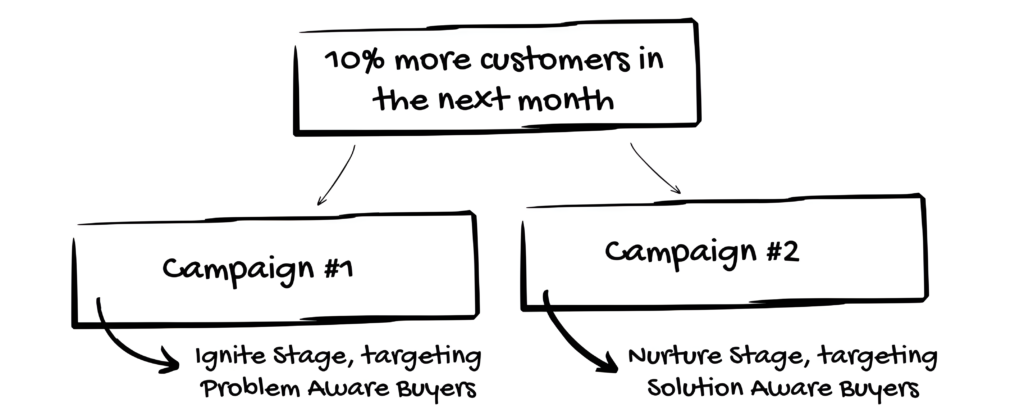
The campaign #1 can be a PPC ad, sure. It can run in a magazine, or it is a display ad on Reddit. It all doesn’t matter now.
What matters in this planning stage is that the ad should support the objective of the marketing plan. To get 10% more customers in the next month. If you have 100 customers and want to have 10% more, all your campaigns must work together to achieve this objective.
Here’s the thing I want to stress.
Marketing = Sales
Keep this in mind when defining your objective. You want to increase your revenue. How do we increase our revenue? By increasing either AOV, PF or the number of your customers.
These three numbers are tracked on the plan level. In our case the number of customers will be increased by 10%.
How to Craft the Perfect Campaign
Each campaign is a tactical execution that fits into the broader strategy laid out in the marketing plan. A campaign will target a specific audience at a particular point in their buyer journey aligned with a specific marketing stage.
I want to emphasize something before we dive into the anatomy of a campaign. I know, you hear campaigns and immediately think about Google Ads, Facebook, whatsoever.
When I talk about campaign it’s not just an ad. It’s a tactical execution. The ad, the offer, the loyalty program, the content piece, …
What you should keep in mind is that a campaign is always a tactical execution for your objective.
What is the anatomy of a campaign? Every campaign will consist of
- customer avatar
- buyer journey
- marketing stage
- budget
- time-based
- channel
All campaigns have an underlying customer avatar based on their buyer journey. You target a specific marketing stage, whether it is Ignite, Gather, Action, Nurture or Flourish.
It has a budget but can’t exceed the budget of the supervisory authority aka your marketing plan. It is also time-based and runs in a channel, for example Google.
And based on the marketing stage you need to track its appropriate metrics. Do I need to track all metrics? I would say yes, if it’s possible. If all campaigns are in the Gather stage it will not make sense to track the Customer Acquisition Cost of course.
But ascending with all the upcoming stages Nurture, Activate and Flourish you can track their metrics also.
Don’t worry, in the next chapter you’ll see a full metric rundown with its calculations, but for now let’s find out what campaigns you could run in a specific stage.
Campaign in the Ignite Stage
A campaign here can be anything to connect with our audience. Advertisements that run in social media, search engine advertising, search engine optimization, content marketing, ads on blogs, in forums, and so on and so forth.
Do you still remember the magic triangle?

The triangle says
Communicate the right message (1) at the right time (2) within the right media (3)
This applies to advertisements as well as for content you publish.
Campaigns in the Gather Stage
Here you offer lead magnets to provide valuable information or for solution-aware buyers a demonstration. The free-trial for SaaS, the sample product for ecommerce. Because the goal is here to provide value each campaign is designed to get the contact information of prospects.
So, a campaign can be a PPC ad that drives interested buyers to a landing page where they can download the information for free in exchange of their information. Or it can also be a content piece where at the end you offer a summary.
Campaign in the Nurture Stage
All emails you run are here, as well as remarketing ads through e.g. Facebook Pixel. Content sequences you publish on your blog and share on your social media profiles.
Our goals? Keep existing leads engaged with valuable content for their individual buyer journey, moving them closer to a purchasing decision. And the second goal is to segment all your leads based on their buyer journey.
The content will vary for someone who is problem aware, solution aware or product aware.
Campaign in the Activate Stage
For example card abondonment email sequences, emails itself that offer time-limited offers to your existing leads. Your product pages, your offers.
Remember, the goal is to remove barriers, so the purchasing process is as easy as possible. Provide social proof, customer testimonials, success stories, case studies, everything you can come up with to provide reassurance.
Campaign in the Flourish Stage
Your goal is to maximize existing business. Leverage your current customers and increase their purchase frequency. After the first purchase ensure customers feel confident about their purchase and provide post-purchase support if necessary.
Implement loyalty programs, offer VIP programs, point rewards for purchases. The end goal is to get referrals and as many reviews as possible.
KPI Rundown
You run a Google PPC ad alright? It’ll target problem aware buyers and run for one consecutive month. The sales copy is irrelevant now.
It costs you $1,300. You got 28 leads and 9 customers afterwards. I’ll show you all the metrics again, calculate them and at the end you’ll see the power behind all of this from a 40,000-foot view.
Let’s start with the Ignite stage – that also fits because you ran an ad here.
Customer Acquisition Cost
CAC = (Total Marketing and Sales Costs) / (Number of New Customers Acquired)
You spend $1,300 and got 9 customers after a certain amount of time. Your CAC would be $1,300 / 9 = $144,44.
Cost per Lead
Cost Per Lead (CPL) = Total Marketing Spend / Total Number of Leads Generated
You spend $1,300 and got 28 leads. Your CPL would be $1,300 / 28 = $46,42
Lead to Conversion Rate
Twenty-eight leads, and nine customers were the result.
Lead to Conversion Rate = (Number of New Customers / Number of Leads) X 100
Your LCR would be (9 / 28) X 100 = 32,14%.
Conversion Cycle
Let’s assume the following days of all nine customers.
| C | 1 | 2 | 3 | 4 | 5 | 6 | 7 | 8 | 9 |
| D | 14 | 4 | 9 | 12 | 7 | 4 | 18 | 9 | 6 |
All days (D) summed up is 83. Your Conversion Cycle would be 83 / 28 = 2,9. So you can say it takes approximately 3 days that a lead becomes a customer.
That also concludes with the Gather part. Now for the Nurture part, we want to follow-up with our newly generated leads. To find out the Conversion Rate as well as the Average Order Value.
Conversion Rate
Your desired action is the purchase. You have your 28 leads on the list. You follow up with email campaigns. I’ve already stated that you got nine customers.
So, the conversion rate for the purchase (hence the lead became a customer) is (9 / 28) X 100 = 32,14%.
Average Order Value
If your product price was $29,99 and was bought by all nine customers. Your AOV would be $29.99 of course. But one customer also bought a complementary product (upsell) for $14,99.
Your AOV would be $284,9 / 9 = $31,65. Now, the Flourish Metrics
Churn Rate
The question is, should you track the Churn Rate based on all campaigns or in total? I’d say, if possible, do both. You should know where your customers come from. From which channel at least. Whether they came from Google, Facebook, Radio, whatsoever.
This gives you the power to calculate the Churn Rate for all channels. You’ll discover that some channels bring in higher quality customers than others. If you know that you can direct your investments to these. Otherwise, you are just shooting darts on the dark side of the moon.
And remember, you must look at this number from the context of the Lifetime Value of your customers as well as the Customer Acquisition Cost.
From this campaign you got 9 customers after 18 days (the max days it took one lead to become a customer). Let’s say we track them for one quarter (3 months). After three months you only have 7 left.
Churn Rate = (Number of Customers at the Start of the Period – Number of Customers at the End of the Period) / Number of Customers at the Start of the Period X 100
Churn Rate = (9 – 7) / (9) X 100 = 22,23%. You lost around 22% of your customers in one quarter that came from this campaign.
For the Review and Referral Rate let’s say you got 3 reviews and one referral. Your Referral Rate would be (1 / 9) X 100 = 11,11% and a Review Rate of (3 / 9) X 100 = 33,33%.
The Lifetime Value
LTV is the health of your company. Acquiring a customer requires marketing, sales and support efforts. Lifetime Value (LTV) is the total revenue a customer is expected to generate for your business over the entire duration of their relationship with you.
It’ll show you how much each one of your customers is worth. There will be campaigns that will bring in customers with an extremely high LTV, while other campaigns do not. This is why I have sometimes said you need to look at certain numbers within the context of the LTV.
Let’s take a look at this picture here to understand the idea behind it better:

The red triangle is the cost of acquiring a customer. The payback of this Customer Acquisition Cost (CAC) takes some time. And then, you earn the fruits of the LTV later on. You should have an LTV to CAC ratio of at least 3:1, meaning the customer generates three times more revenue than it costs to acquire them. This gives you enough playground for your cost of attracting a new customer.
What does it mean for you?
It is absolutely okay to lose money when acquiring a customer if you have your LTV under control.
To calculate LTV, multiply Average Order Value (AOV) by Purchase Frequency (PF) and then multiply by Customer Lifespan (CL) (the average time a customer stays active with your business).
LTV = AOV × PF × CL
For example, if you have:
- AOV = $50 (average spent per order)
- PF = 4 (purchases per year)
- CL = 3 years (average customer lifespan)
your LTV would be 50 × 4 × 3 = $600. This means the average customer is worth $600 over their lifetime (3 years).
You know you can spend up to $600 to acquire a customer and you’d break-even. Of course, you wouldn’t want to spend so much but what about $100? You know in the first year you will earn $200. So the acquisition cost is covered.
Knowing this number gives you power to invest smartly.
Track the LTV for all channels individually and for all your customers summed up if you can. This gives insight into how much you can afford to attract a new customer in as specific channel and overall.
For your competitors it may seem that you lose money while you know that your typical customer will spend $300 during his “lifetime” and hence the advertising efforts will pay off.
How to Create Winning Marketing Strategies
By now you know the five marketing stages. You know the buyer journeys. You know that your message must always be relevant. Whether it is for an ad, in your email on your homepage on social media.
It must connect on a deeper level with your audience, or they will not listen to your message.
Using marketing plans to group together campaigns that all in the end fulfill the same goal will help you to spend your marketing budget wiser and help you to keep everything organized.
But how do you produce a strategy? Do you need a strategy and if so, how do you create a successful one?
First, where do we put our strategy? Look at this pyramid here.
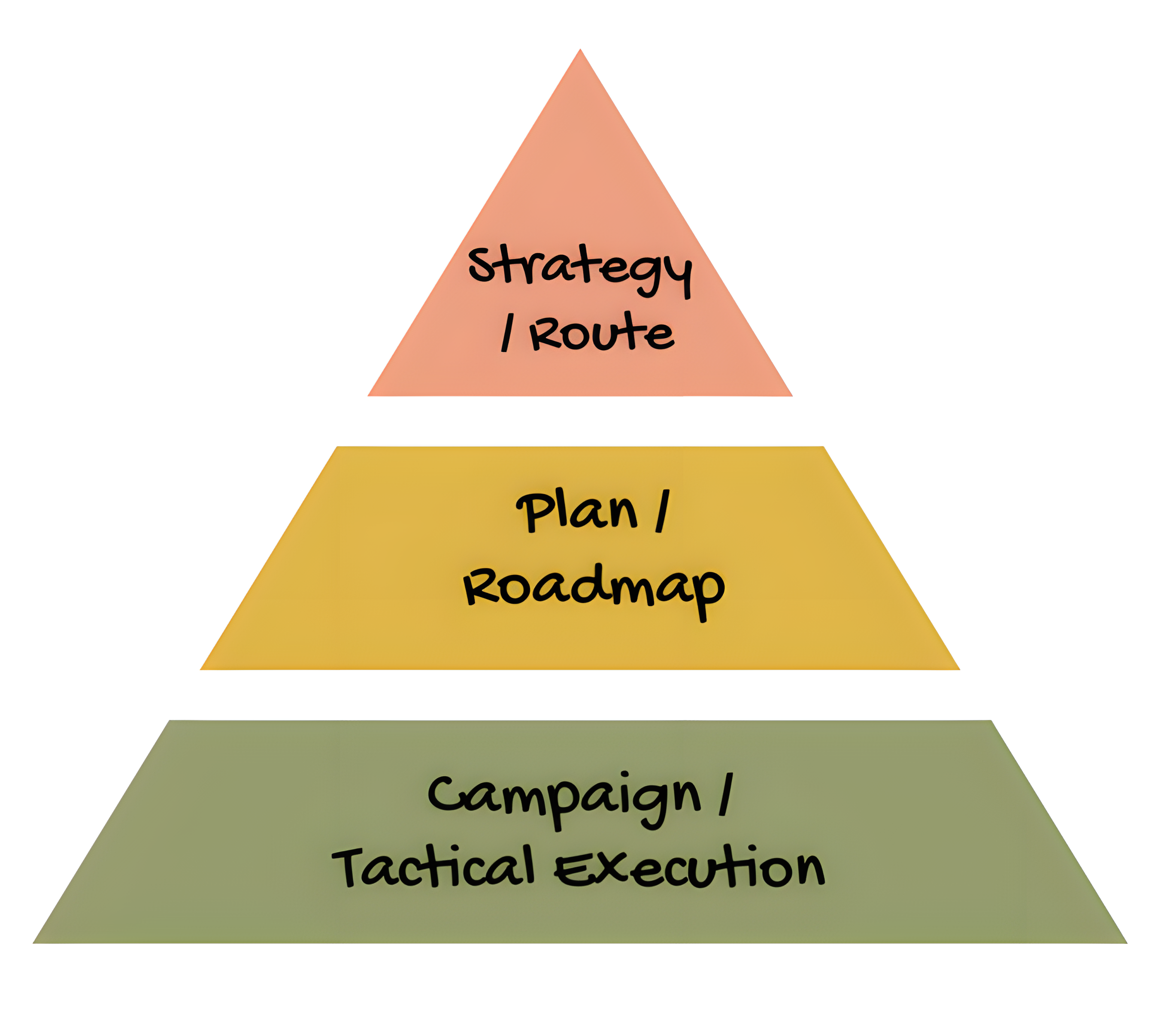
We have already talked about the tactical execution of our objective, the campaigns. The plan is the roadmap, the organizational part of marketing, remember? It holds the budget and defines how long we have time to achieve our objective.
The strategy is the owner of all plans. The biggest mistake you can make is to just create plans, assign campaigns and try to wiggle it. Even if you track your KPIs for all stages and write perfect messages based on the buyer journey you need a route.
Where do you want to go with all your marketing endeavors? To grow my business! Of course. But again, we need an approach that can also track this goal.
How do you define “growth”?
How can you say after a few plans that your business did in fact grow? I got more customers! More revenue!
While this is valid. I personally recommend tracking strategy level three metrics.
And all plans should focus on increasing these metrics.
The Cockpit Numbers
There are only three metrics you need to know in order to increase your revenue, respectively grow your business.
You should aim to always increase the three following numbers:
- Purchase Frequency
- Average Order Value
- Number of Customer
The huge problem is that 99% of all business owners try to focus on the last number. It’s like “I have more customers than you!”
It’s not a competition.
The goal as a business owner is always to be strategic and smart about marketing and growth.
So, the rule of thumb here is to first
Maximize then multiply.
Don’t focus too intensively on always acquiring new customers. First, come up with different ways to increase the frequency of purchases as well as strategies to increase the average order value whenever possible.
Work within your existing budget and increase the Average Order Value and Purchase Frequency.
How?
The easiest tactic here is to foremost increase prices. Most of them we – as entrepreneurs – undervalue our products. But only pricewise. We know the value. We know what we could possibly charge but often we don’t do it.
So, think about your current prices and increase them by 20%. I suggest you run an A/B test and drive half of the traffic to the product page with the increased price and the other half to the old page with the old price.
Price testing is hard, complicated and often you need some tweaks till it works. That’s why I suggested A/B tests. It’s the easiest and most cost-effective way to do it.
Do your customers often buy particular products in bigger quantities? How about you don’t sell the product once but as a pack of two? A pack of four? And simultaneously increase the price. Here you also have a valid reason to do so.
Bundle products that fit together and use them for cross-sells and upsells to increase your AOV and further the LTV. Allowing you to spend/invest even more to acquire a new customer.
It’s a pure number game here.
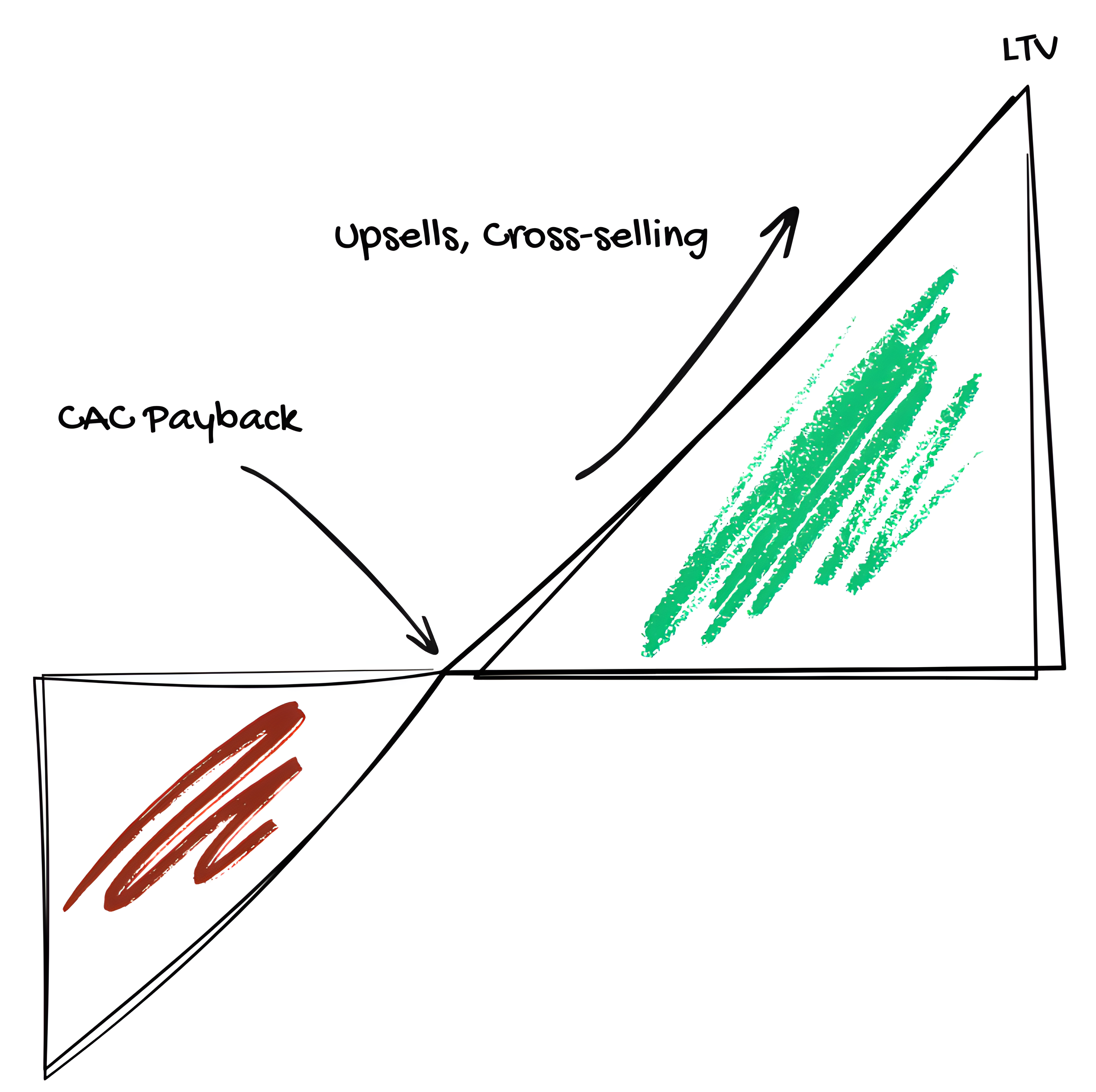
A simple email campaign can be used to increase the AOV after the first purchase. Someone who has just purchased a product will probably purchase again on the same day if you send him a limited-time discount offer, for example.
And it’s the easiest thing you can do right now. Find out what your existing customers often buy together, are there particular products they buy later?
Take a look at your data, what do people purchase and what would probably fit together?
Let’s assume the following numbers:
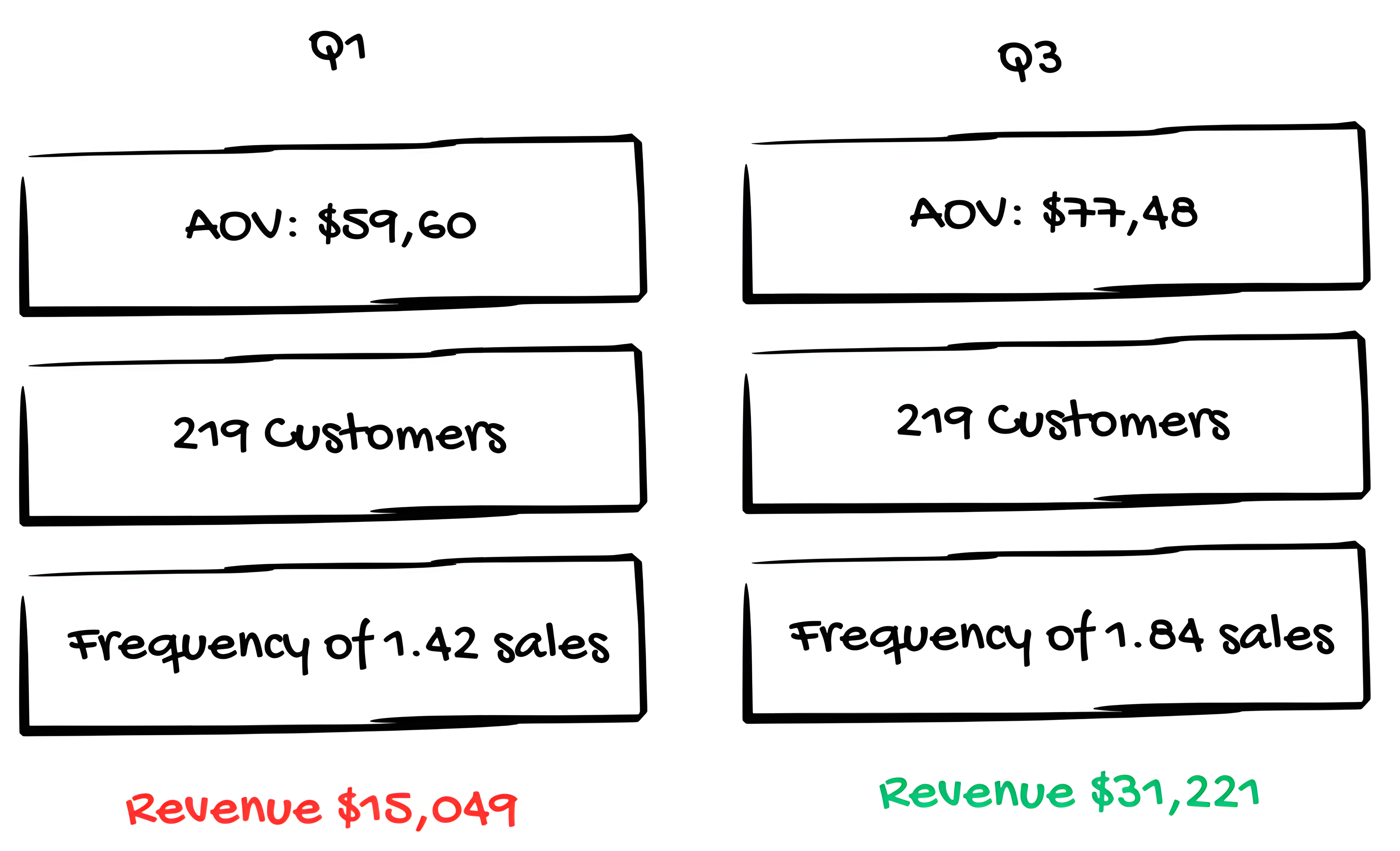
You have doubled your reveneue within 100 days just by increasing both AOV and Purchase Frequency by 30%. And 30% isn’t a lot if you look at the numbers.
Your numbers may be lower or even higher. Yet most businesses don’t think about maximizing. They always target more traffic, because more traffic will sooner or later lead to more customers and thus more revenue. And while this is true, you should rather invest your time to maximize your current efforts.
The best thing is, that you don’t need to increase your marketing budget to achieve this.
How to Increase the Purchase Frequency?
The best way to increase it, is by communicating more with you customers. Or in other words, optimize their experience. So, they will probably buy again.
Think about loyalty programs (such as Prime) and subscription services like the Dollar Shave Club. Can you come up with similar ideas? If you have a product that will deplete over time, do you offer a subscription? Can you give away points for each purchase that will lead to discounts?
The best way to convert one-time buyers into repeat buyers is by offering products that fit for their recent purchase. If you know what your customers usually purchase you’ll probably already know what product you could offer.
Take a look at your data and find out what would fit together and what customers usually purchase; can you find a pattern? Map out the purchase-journey and use them to increase the frequency of purchases of your existing customers.
The Marketing Machine
I understand that some of you may now say, “and how is this supposed to work together?” – and I feel you.
Don’t worry.
Let’s take a look at this blueprint here and let me explain.
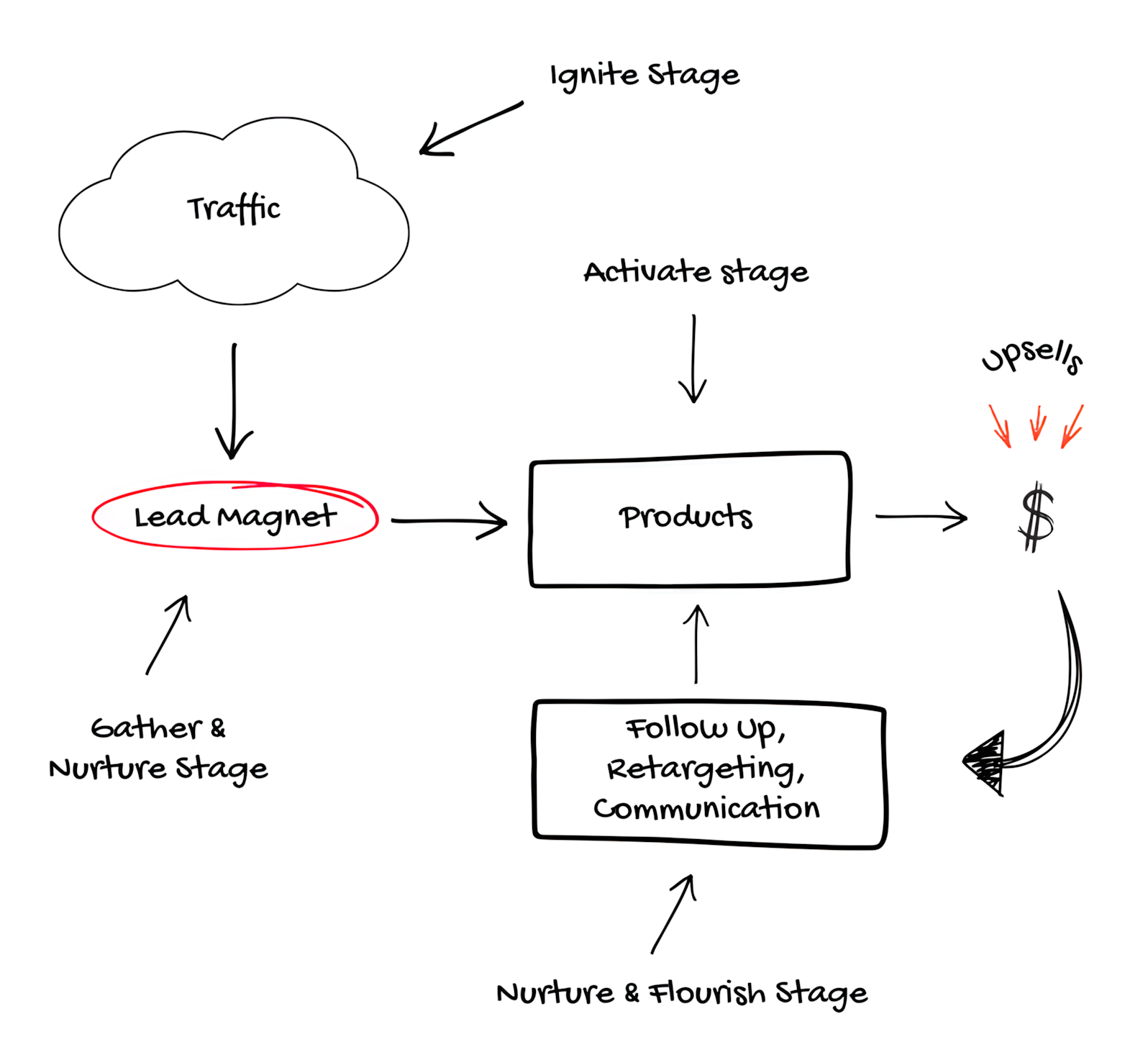
I call it the marketing machine because it shows you what happens behind the curtains. Everything you see, everything you do can be found in this picture. We have talked about Strategy > Plan > Campaign, you remember?
It is in the picture.
Your strategy may be – as we said – to increase AOV and PF, you see it in the picture?
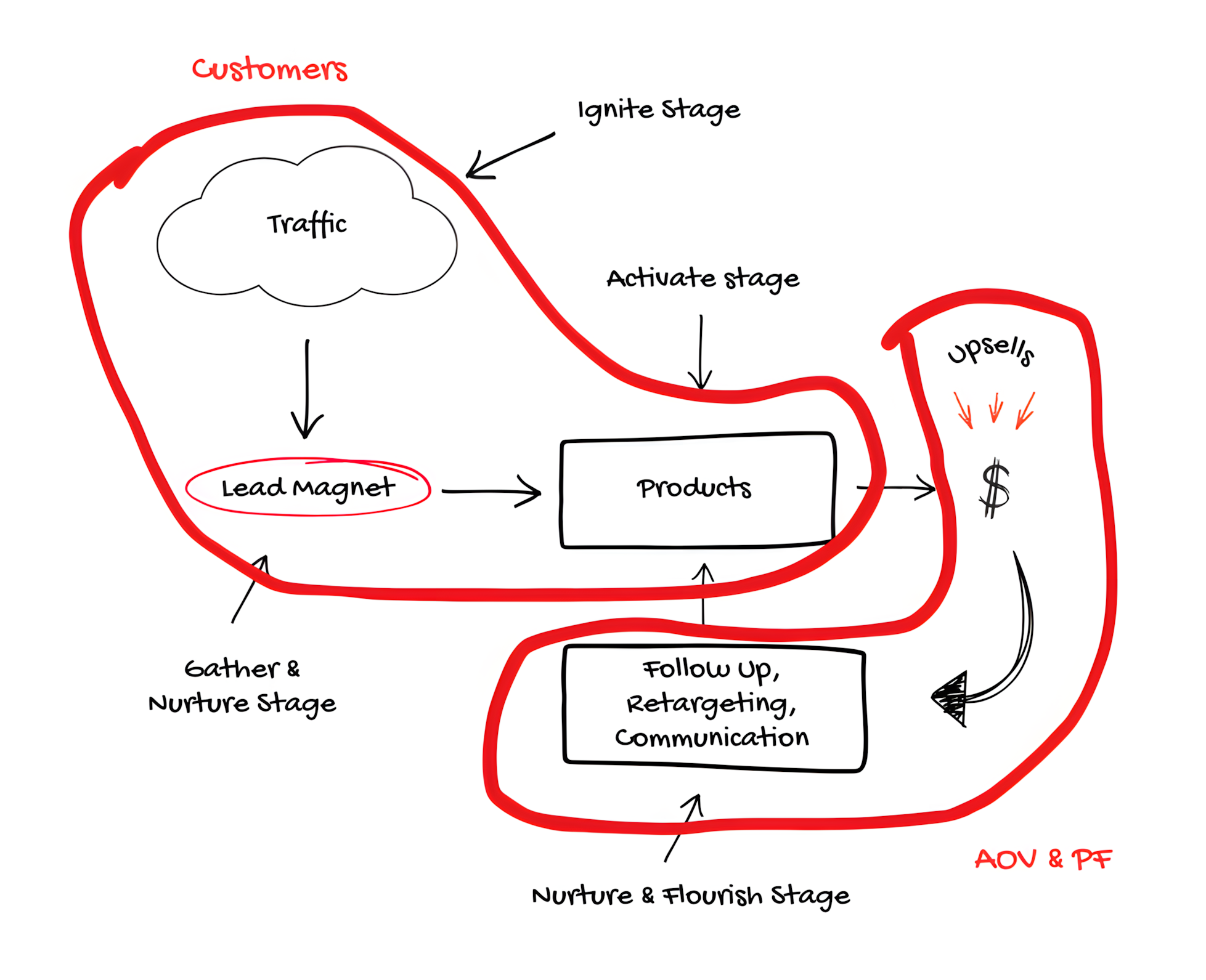
Or if you focus on the multiply part and want to attract more customers, again, its in the picture.
You see, in the end here is what you always do…
- Lead Magnet
- Main Product
- Maximization via upsells, cross-sells, bundles, etc.
- Engagement to build social equity
This is for most business the high-overview process of all marketing efforts.
You have your traffic sources: Advertisements, Social Media, Blog Posts, whatever.
Every click must have an intent. Whether it is the picture you just posted on Instagram, or your paid ad.
You drive them to a specific page.
A product page, sales page, homepage or how most people call it – a landing page.
Here you offer some sort of Lead Magnet.
A Lead Magnet may be a fourteen-day free tial or a sample of your product, a sneak-preview of your service whatever.
You provide such lead magnet because it’s a low-entry for them. You don’t ask for their money.
They don’t know you and first want to see if your are trustworthy.
The idea is to get gather their contact information so you can follow up. After the lead magnet is consumed you aim for the sale. During this time period you of course stay in touch with them.
Now, the Activate stage follows. Immediately after the first purchase you want to maximize your profits.
You already know this, so you add upsells, cross-sells, bundles, subscriptions etc. Now the Buyer Journey is completed, the Customer Journey begins and you move them to the appropriate list to communicate with them and of course to sell to them again later on.
This cycle always continues.
The upsells exist because you want to maximize your Average Order Value; you communicate with your existing customers to encourage repeat purchases (Purchase Frequency) and the traffic with its appropriate landing page exists to attract new customers.
Broken down the process looks like this

This is the high-level overview of all ads, Social Media posts, blog posts whatever. You can stick to this process and to the blueprint you’ve just seen, because its simple, easy and it works.
How does all this work together with the Strategy > Plan > Campaign approach? The Prism Model? It’s simple.
We’ve talked about the strategy to grow your business, remember? You first want to maximize then multiply. So, if you already have customers you focus on AOV and PF – as seen in the blueprint above.
Your strategy is to increase the AOV. So, you craft your plan with the objective to increase your AOV by 30% in the next two months and add tactical executions to it.
These tactical parts may involve email campaigns, technical changes on your checkout page to offer complimentary products and so on.
You work within the part of the marketing machine.
You focus on number three Maximization via upsells, cross-sells, bundles and number four Engagement to build social equity.
And if you maximized your AOV and PF and now want to attract more customers, you again work within the machine.
But now you focus on number one Lead Magnet and number two Main Product.
This is what happens behind the scenes.
That’s strategic marketing.
I showed you that in the end there are only four steps within such machine, right?
- Lead Magnet
- Main Product
- Maximization via upsells, cross-sells, bundles, etc.
- Engagement to build social equity
Now, the question arise, how can you build such machine and implement it in your business?
The idea behind all this is to create a system that brings qualified leads, turns them into customers and then resells to them. And of course, this should all run on autopilot.
So, to create such system you need to
- Get your advertising message in front of the right prospects
- Capture their contact information by using lead magnets
- Use follow-up marketing messages to engage with these leads
- Turn these now “ready to buy” leads into paying customers.
- Send again follow-up messages to turn one-time buyers into loyal, recurring customers.
Do you see it?

Again we have the Prism Model in front of us. So, everything I’ve told you so far, the Buyer Journeys, the Prism Model, the Marketing Intersection and the KPIs, everything fits into this machine.
This is what you do.
Always.
You follow this layout that serves your overall marketing strategy with all its plans and campaigns.
Why Marketing May Fail Even If You Follow This Approach
The issue is that most business owners try to stand out by being louder. The reason why they do this is quite simple, because they copied their competitors approach and thus have to be louder or otherwise they’ll be ignored.
The truth is depending on your market your potential customers may have heard it all. The promises, the guarantees, the features you claim, the benefits, … everything.
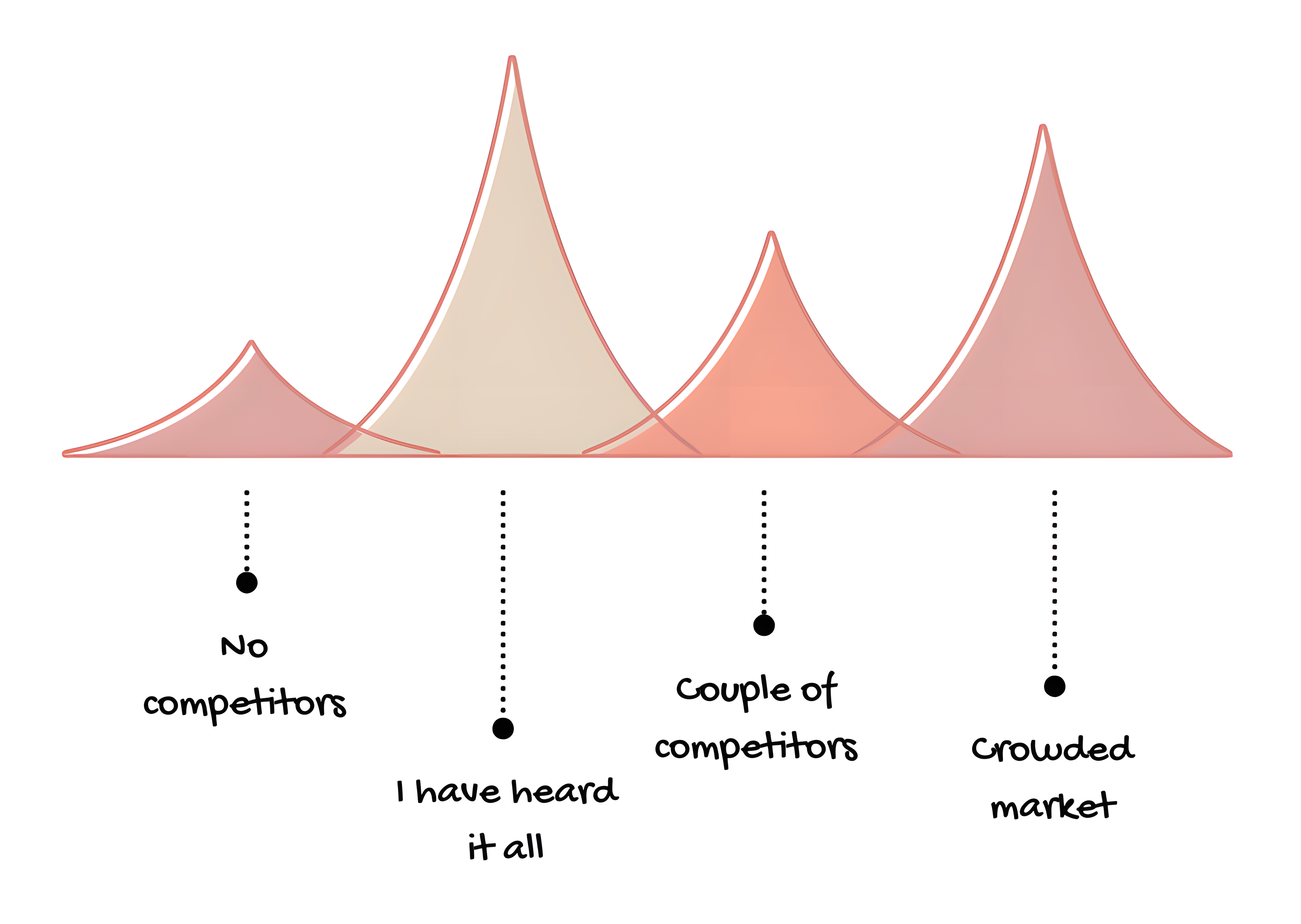
There are four stages of your market. You can be the first one in the market and have no competitors, that’s easy.
If you just have a few other competing businesses you don’t need to be creative.
When potential prospects have heard it all, it can become hard to stand out. And if you operate in a crowded market – weight-loss for example – its terrible to advertise.
If you product is not legitimately unique you may have a hard time doing marketing in any stage of the market where other businesses offer the same product.
No competitors
You are probably the first in the market. Your prospects have never received any information about a product like yours before. This is, as you can think, easy.
You can just advertise your product with its benefits.
Couple of competitors
If you have some competitors find out what they’re claiming, their benefits, their offers and trump it. Of course, you need proof to back the claims up! If you can, trump their benefits and differentiate yourself.
Ask yourself
What is the unique or greatest benefit I can give to my customer at a superior level than my competitors?
Find the answer to this question and position yourself and your marketing around this.
They have heard it all
This can become a bit harder. Prospects have heard it all. The claims, the benefits your product offers, the guarantees, etc.
You need to change the way you promise your products benefits. You need to introduce a unique mechanism. Something that makes your product stand out. You can’t advertise a promise or just a plain benefit.
You need to shift the perspective of your prospects. Advertise the mechanism.
How can you do that?
Wrap it around an idea that changes the perspective of how your customers see your product
You don’t need to change the product, yet if you can truly distinguish it, then go ahead. Otherwise you need to change the angle of how you advertise your product.
Now, I know this sounds a bit philosophical. Don’t worry. Itself its pretty simple. Simple to understand, but not simple to do.
Your job is to educate your potential customers about the REAL reason why past solutions didn’t work or bring them the result the wanted.
You achieve this by explaining that their knowledge about the problem is incomplete and they have been missing a crucial piece of information that has been holding them back.
P90X is a perfect example of how shifting the angle of an advertisement changes the way customers perceive a product. Instead of just saying, “This workout will help you lose weight and get ripped,” they introduced a concept – Muscle Confusion – which completely changed how people thought about fitness.
Most fitness programs at the time focused on straightforward workout routines with basic progressions. P90X didn’t just sell a workout program, it sold a new way of training that exposed a critical flaw in traditional workouts.
Their message was:
“The reason you’re not seeing results isn’t because you’re not working hard, it’s because your body has adapted! Traditional workouts fail because they don’t challenge your muscles in different ways, leading to plateaus. With P90X and Muscle Confusion, your body never adapts, so you keep burning fat and building muscle consistently.”
Why This Worked:
- Reframed the Problem: Instead of saying “You’re not working hard enough,” they said, “The workouts you’ve been doing are the problem.” This removed blame from the customer and gave them hope.
- Created a New Perspective: The idea of “Muscle Confusion” made customers feel like they had discovered something new, something revolutionary.
- Sold a Concept, Not Just a Product: Instead of just selling workouts, they sold a methodology, making P90X feel essential rather than just another fitness program.
How You Can Apply This to Your Product:
- Identify the existing belief your customers have. (Example: “Diets help you lose weight.”)
- Show why that belief is incomplete or flawed. (Example: “Diets fail because they slow your metabolism over time.”)
- Introduce a unique concept that shifts their perspective. (Example: “Our system focuses on metabolic flexibility so your body burns fat efficiently, no matter what you eat.”)
This is how you make your product stand out.
By teaching customers something new that makes them see old solutions as inadequate and your product as the missing piece. And “unfortunately” you absolutely MUST do it nowdays.
Otherwise they’ll will just toss your ad away and say “Yep, I have heard that before.”
Crowded market
In this stage your competitors start to copy your mechanisms. Your offers, promises, benefits, claims, whatsoever.
Your job is to come up with a NEW mechanism that again shifts the perspective of your prospects.
Conclusion
I sincerely hope that you’ve found some ideas that will help you on your marketing journey.
And that this approach lifted the curtains of marketing that sometimes seems so claudy.
If you know someone who needs to know this, then please share it.
The less people purchase overpriced courses the better.
A personal anecdote, – if you allow me -, stop consuming information if you can’t put it into action immediately. All the books, the courses, the podcasts, hurt you more than you may think. I especially mean all those high-priced courses that target young entrepreneurs, business owners and marketers.
The more you know the more you get stuck, at least that is what I have found out over the years.
Stick with the fundamentals
and build upon them.
If you want to enhance your skills, I recommend you to read the following books (order doesn’t matter)
Scientific Advertising, Ogily on Advertising, Reality in Advertising, Breakthrough Advertising and My First Sixty Years in Advertising
If you read these books, you’ll know more about direct response advertising and copywriting than most CMOs out there.
To your success,
Dominik
Leave a Reply